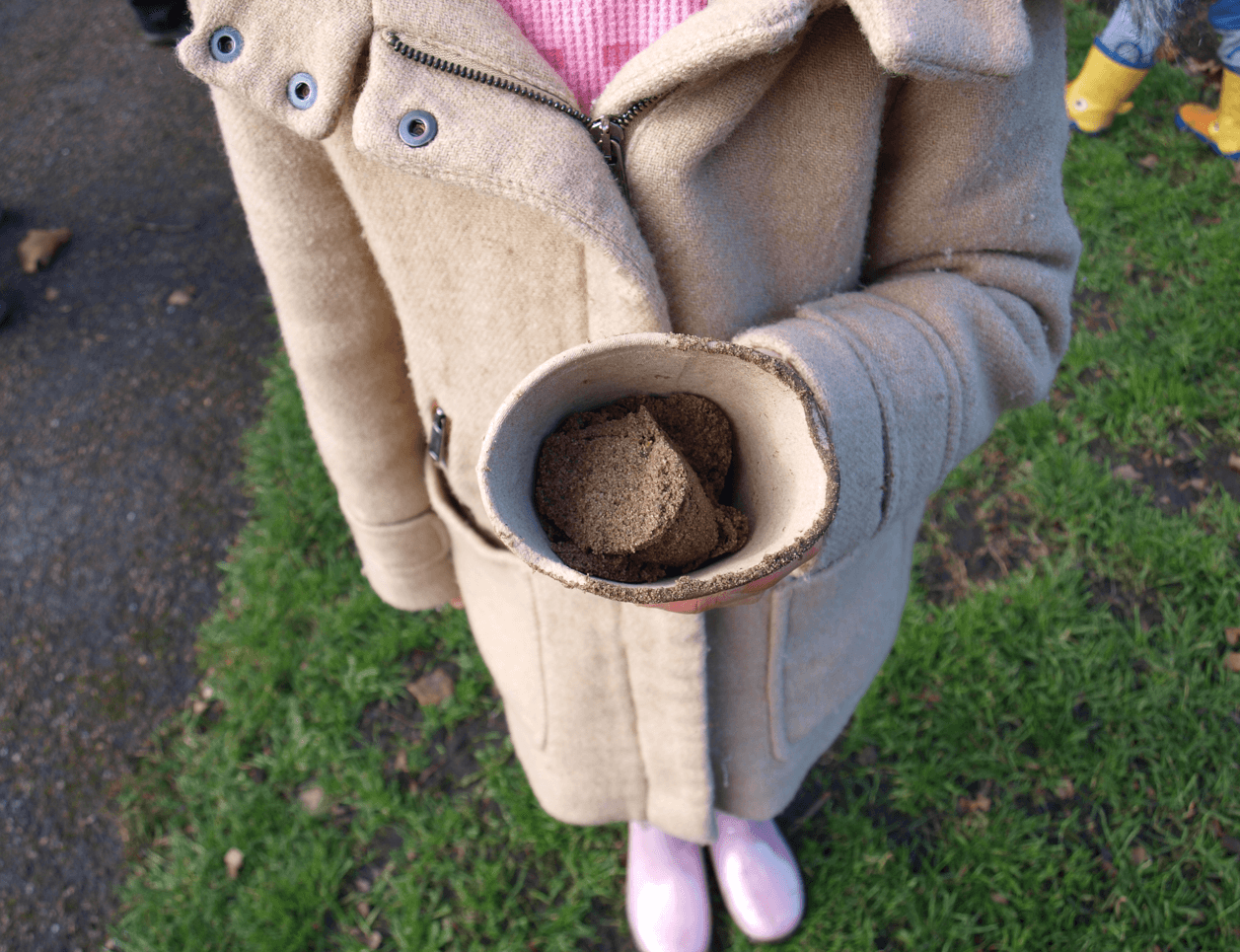Remembering Professor Robert Lee
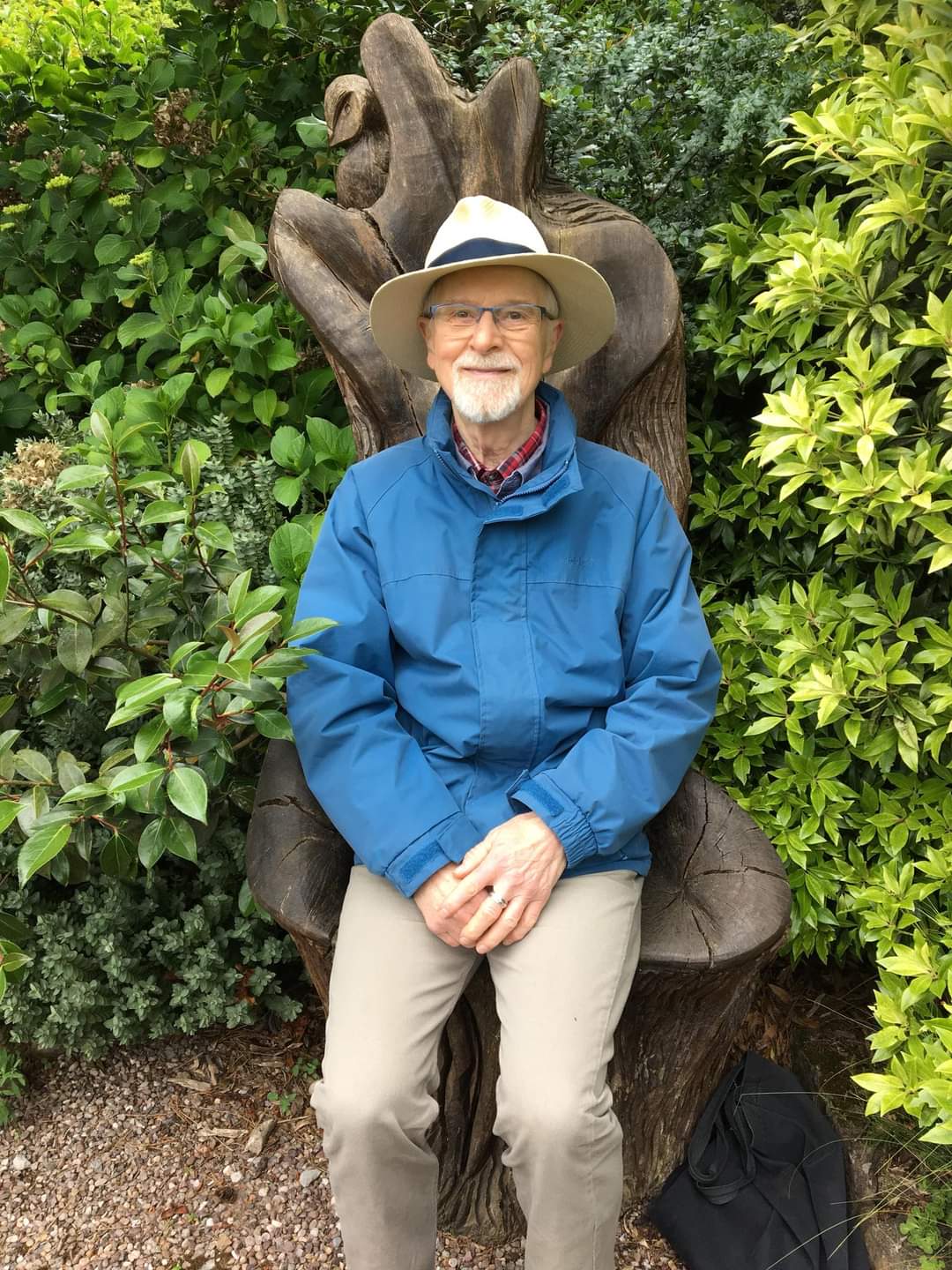
We regret to announce that Birkenhead Park recently lost its most devoted and vital advocate: Professor Robert Lee (1946- 2024), former Chair and President of the Friends of Birkenhead Park.
In his own words, Birkenhead Park has been part of Robert’s world for a very long time, and indeed, he was born and raised on the outskirts of the Park, 334 Park Road North, before moving to his parents’ first (and only) house, 37 Park Road South. In the eighties, his wife Kicki and he moved to Cavendish Road, where they raised their 4 children.
This life-time connexion to Birkenhead Park surely influenced Robert’s interest for the world’s first publicly funded municipal park. By the mid-eighties, he was already a committed member of the Friends of Birkenhead Park, at a time when the Park was suffering from reduced funding and rising levels of anti-social behaviour.
Robert was an Emeritus Professor at the Department of History, University of Liverpool, with a particular expertise in social history. He developed an extensive knowledge about the Park’s history, which he gathered in the first critical and comprehensive book about the Park: Birkenhead Park: The People’s Garden and an English Masterpiece, published a couple of months ago by Liverpool University Press.
Robert is the mastermind behind the UNESCO World Heritage bid for Birkenhead Park. It is a project he strongly believed in and actively and enthusiastically supported, becoming a key member of Birkenhead Park’s World Heritage Steering Group to drive forward the ambition. His efforts were rewarded in April 2023 when the UK Government announced that Birkenhead Park, the pioneering People’s Park, was shortlisted to be nominated to UNESCO as a World Heritage Site.
The legacy he left is immense and will not be forgotten.
We are delighted to announce that Professor Robert Lee has released his book on a detailed history of Birkenhead Park – Birkenhead Park: The People’s Garden and an English Masterpiece. This new book is the first critical, comprehensive history of the first publicly funded park, globally.

Professor Lee’s work establishes the significance through his research of the park, emphasising the how Birkenhead Park was a pioneer in the development of urban public parks, designed for use by everyone. Birkenhead Park was labelled “the people’s park” and the book further describes how irrespective of social class, ethnicity or age Birkenhead Park become the local green space for health and wellbeing, for all. Additionally, Professor Robert Lee’s book celebrates the creative genius and design skills present in Paxton’s original design of Birkenhead Park. His work identifies the Park’s significant contribution to the public park development and nineteenth-century landscape history on both regional and international scales.
The book is beautifully illustrated with 60 colour images, drawing on a wide range of contemporary material and the professional skills of local photographers.
Order your copy from Liverpool University Press through this link.
Order nowThe launch of Professor Robert Lee’s fantastic book was at Birkenhead Park visitor centre and was truly a beautiful event. With support from the Friends of Birkenhead Park and Liverpool University Press, Wirral Council and Birkenhead Park’s team were delighted to welcome attendees from across the country to celebrate Professor Lee’s exceptionally talented work.
Borough of Culture celebrations 2024, hosted alongside Luke Jerram’s ‘Gaia’ artwork installation.
28th of May - 30th of May 2024
The installation will be presented alongside three days of entertainment and activities produced by outdoor arts organisation Walk the Plank.
We hope to see you here!
Check out the programmeBe a part of Borough of Culture 2024.
Get involved. This programme around Gaia is produced by outdoor arts organisation Walk the Plank
Birkenhead Park is a step closer to achieving the highly coveted UNESCO World Heritage Site status!
Following the submission of our application in July 2022, the Department for Digital, Culture, Media and Sport announced on Monday 10th April 2023 that Birkenhead Park would be included on the UK Tentative List for potential nomination for inscription on the UNESCO World Heritage List. While inclusion on the Tentative List does not guarantee a site will progress to be nominated to UNESCO, Birkenhead Park’s inclusion on the Tentative List is still seen as a significant step closer to that goal.
The World Heritage Status inscription is awarded by UNESCO (United Nations Educational Scientific and Cultural Organisation) to sites which are determined to have Outstanding Universal Value and makes the final decision on which locations become World Heritage Sites from lists of potential locations submitted to it by governments. The UK Tentative List includes sites that could become future UNESCO World Heritage Sites over the next 10 years. We don’t yet know if or when we’ll be nominated by the UK Government, but we’ll be working hard over the coming years to secure our nomination.

Birkenhead Park as a World Heritage Site would add to its international recognition and acknowledge the role it played as the forerunner for the public parks movement. It would be a massive achievement for the park, the wider community, and for Wirral. The Friends of Birkenhead Park, along with Wirral Council, have been working towards this goal for several years. It is hoped that the park’s success will boost the regeneration of Birkenhead and cement its historical significance in the development of urban public parks around the world.

Birkenhead Park’s inclusion on the UK Tentative List is an important milestone for the park’s potential to become a World Heritage Site. Birkenhead Park is a unique public space that has served the community for over 175 years, and this recognition is a testament to its historical, social, and cultural significance. We look forward to following its journey towards achieving this prestigious designation, and we’ll keep everyone informed of our progress in the coming years!
Do not hesitate to subscribe to our newsletter at the bottom of this page to stay updated.
Let’s bee friends!
This year, you’ll see new pollinator beds growing in your lovely park.
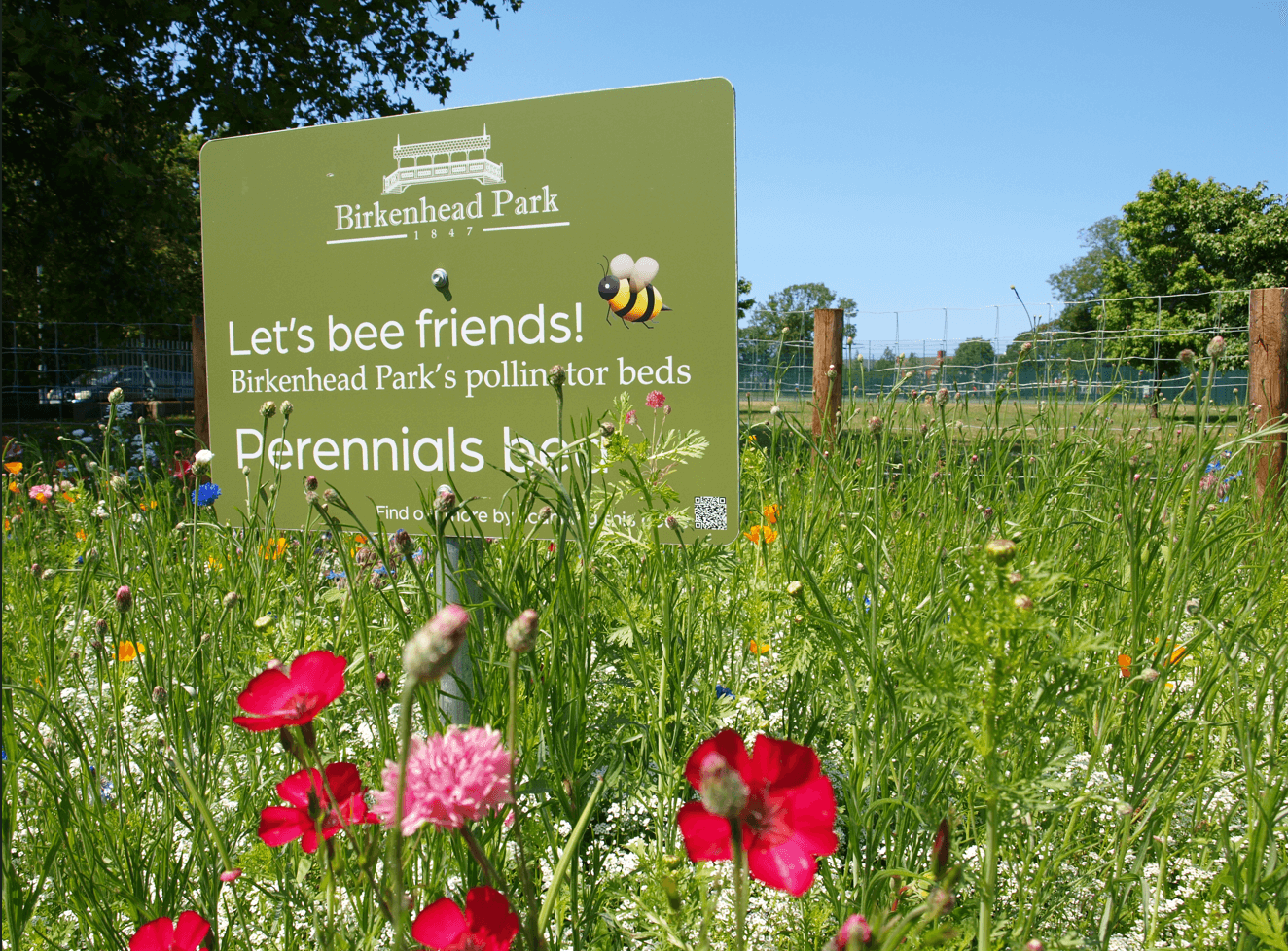
What’s the plan?
Mid-February, the park’s gardeners removed turf from the ground, thus creating two different areas ready to be sowed. They also marked an area of grass that they have stopped mowing to enable us to see what happens if we just let the existing grass grow – that was the Wild Bed.
As expected, towards the end of Summer, we could see that this bed did not produce any flowers. It shows that wild flowers will grow themselves only in certain conditions. Eventually, the Wild Bed was mown, but we have recorded the results.
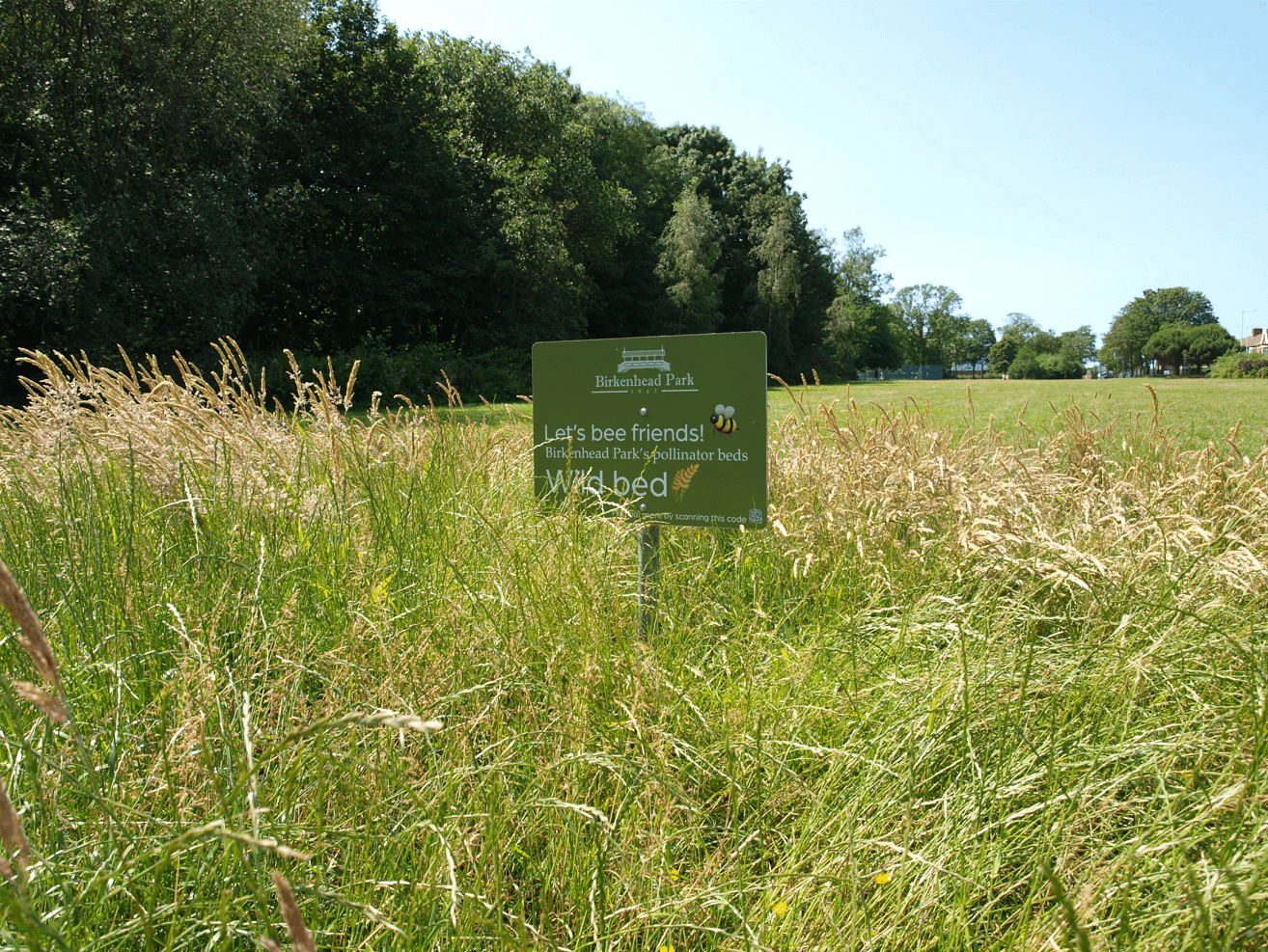
Meanwhile, our junior rangers successfully sowed different seeds in the two other beds in the late Winter.

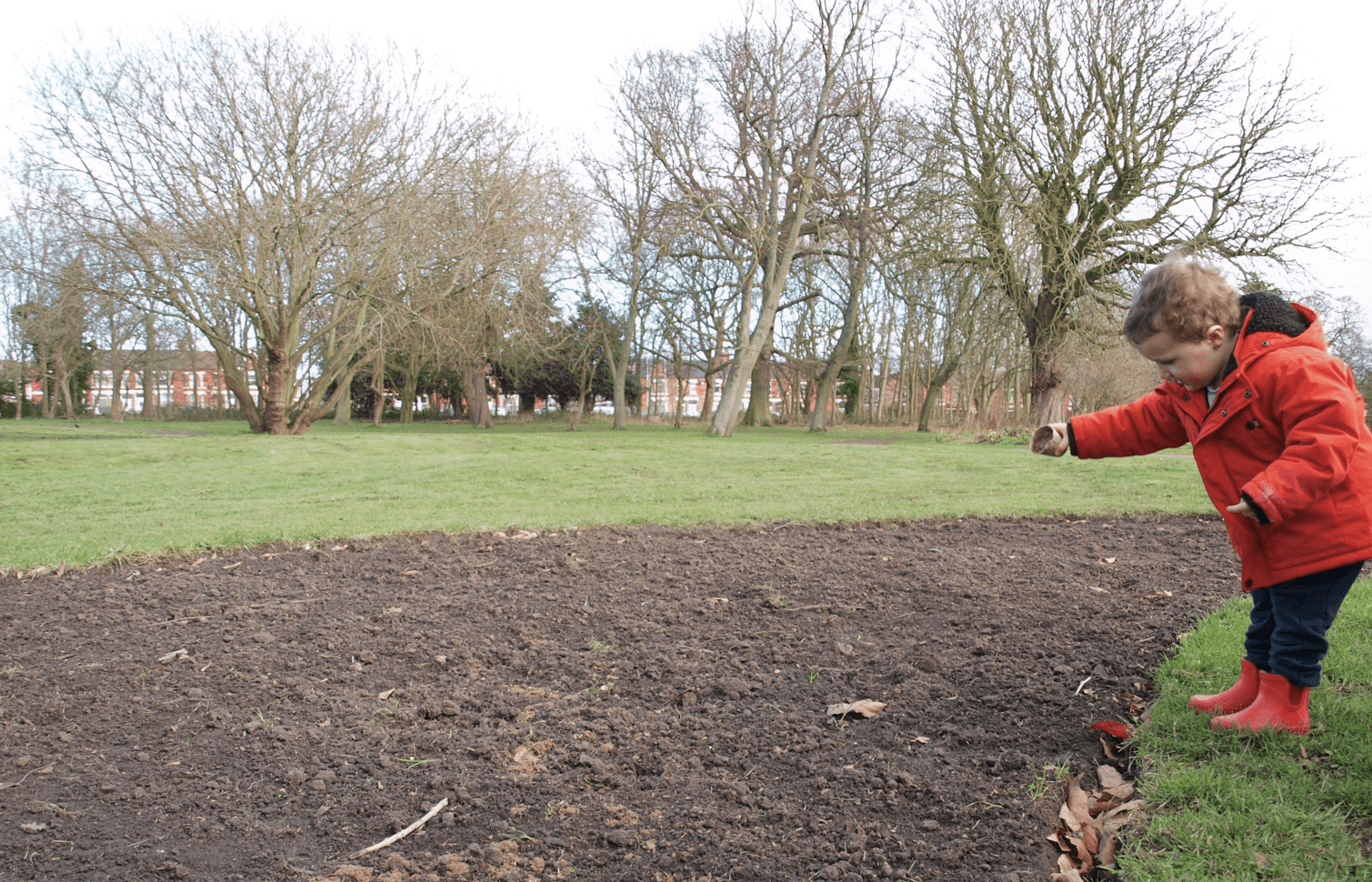
The Annuals Bed demonstrated what happens when an “annual” mix of flowers is sown. In this area, we found a number of species including Purple and White Alyssum, Californian Poppies, Cornflowers and Marigolds in a low-flowering display. We expect to see these flowering for one year only (as the “annual” name suggests), with seeds needing to be re-sown every year. Many of the species seen in this area are non-native.
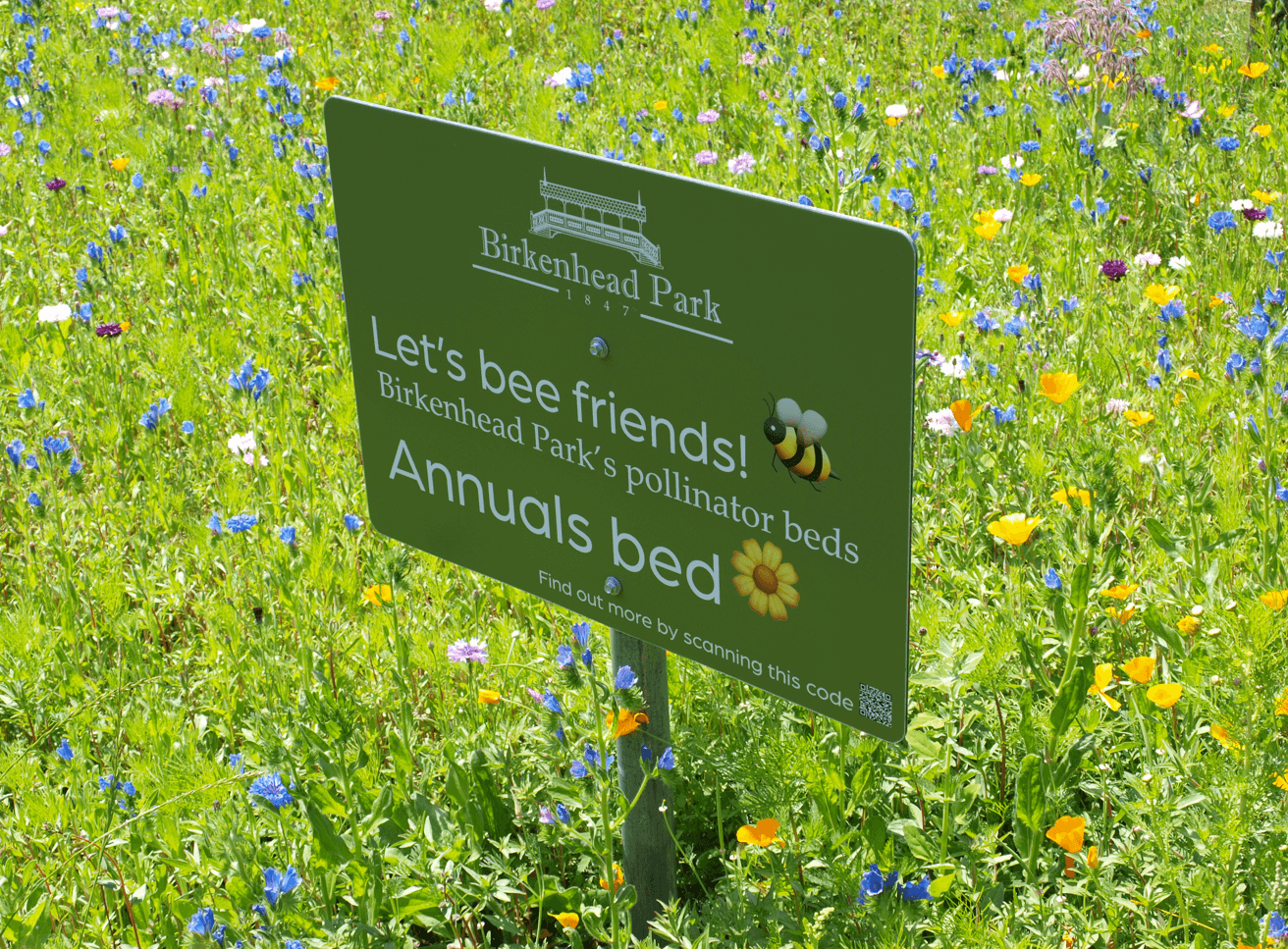
The Perennials Bed has a mixture of perennials (55%), annuals (20%) and biennials (25%), which will show some colour in the first year, but will take time over the following years to fully establish and flower. The species here include cornflower, musk mallow, field scabious, wild carrot, soapwort and forget-me-nots. Typically, this mix should flower at different times of the year presenting a variety of colours, all of which are very attractive to pollinators. Much of the species here are native flora.
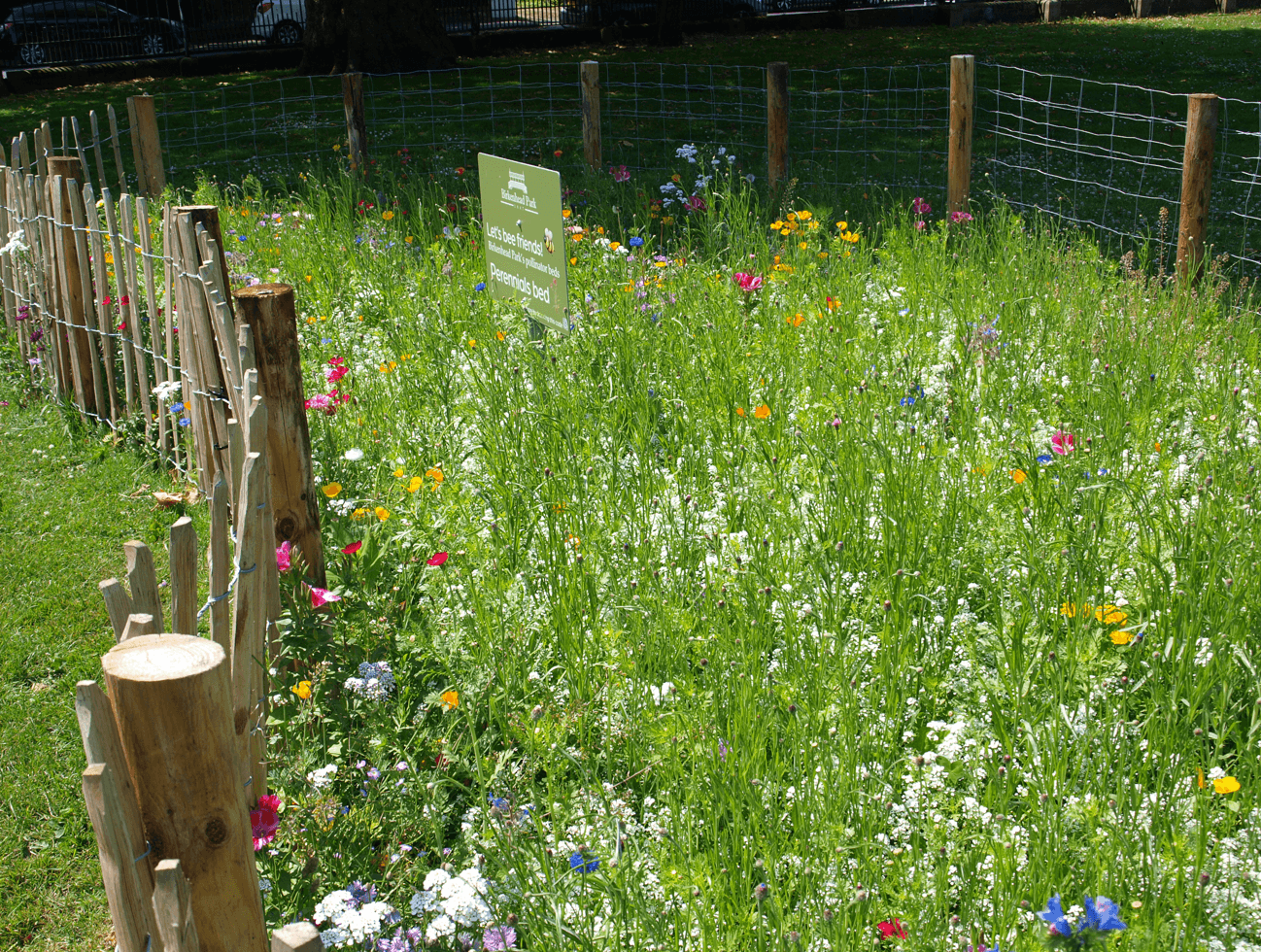
Let’s bee friends!
What are pollinator beds for? Why are they so important?

Garden plants can be sources of nectar and pollen. Pollinator bed habitats support insects and other wildlife.
In the UK, we need a wide range of plants to provide pollinators (bees and other insects that pollinate plants) with local food sources across the seasons – including times when crops aren’t producing flowers.
Many of our favourite fruits, vegetables and nuts rely on insect pollination. For example, in the UK strawberries, raspberries, cherries and apples need to be pollinated by insects to get a good crop.
Currently, the insects do this job for free! But if the UK doesn’t have a large enough insect population we may need to develop artificial pollination methods, which takes a lot of time and is expensive.
As many gardeners know, insects and other animals can also help in the fight against crop pests (animals and insects that damage crops and plants). This means that farmers may have to rely even more heavily on pesticides if these ‘good’ animals and insects can’t help.
Plants also contribute to scientific and medical research. Some UK native wildflowers contain compounds which can be used in drugs to treat diseases. For example, foxgloves (Digitalis purpurea) contain chemicals used to treat heart conditions. If we were to lose wildflower species, we could lose potential new medicines.
Just as importantly, perhaps, garden plants are beautiful and provide us with habitats that buzz with life.
There are also strong cultural bonds that exist with recognisable species such as poppies, which remind us of lives lost in world wars, or of dandelions which may remind us of childhood summers.
How do garden plants help the environment?
Garden plants provide lots of things that insects need: food in the form of leaves, nectar and pollen, also shelter and places to breed. In return, insects pollinate the garden plants, enabling them to develop seeds and spread to grow in other places.
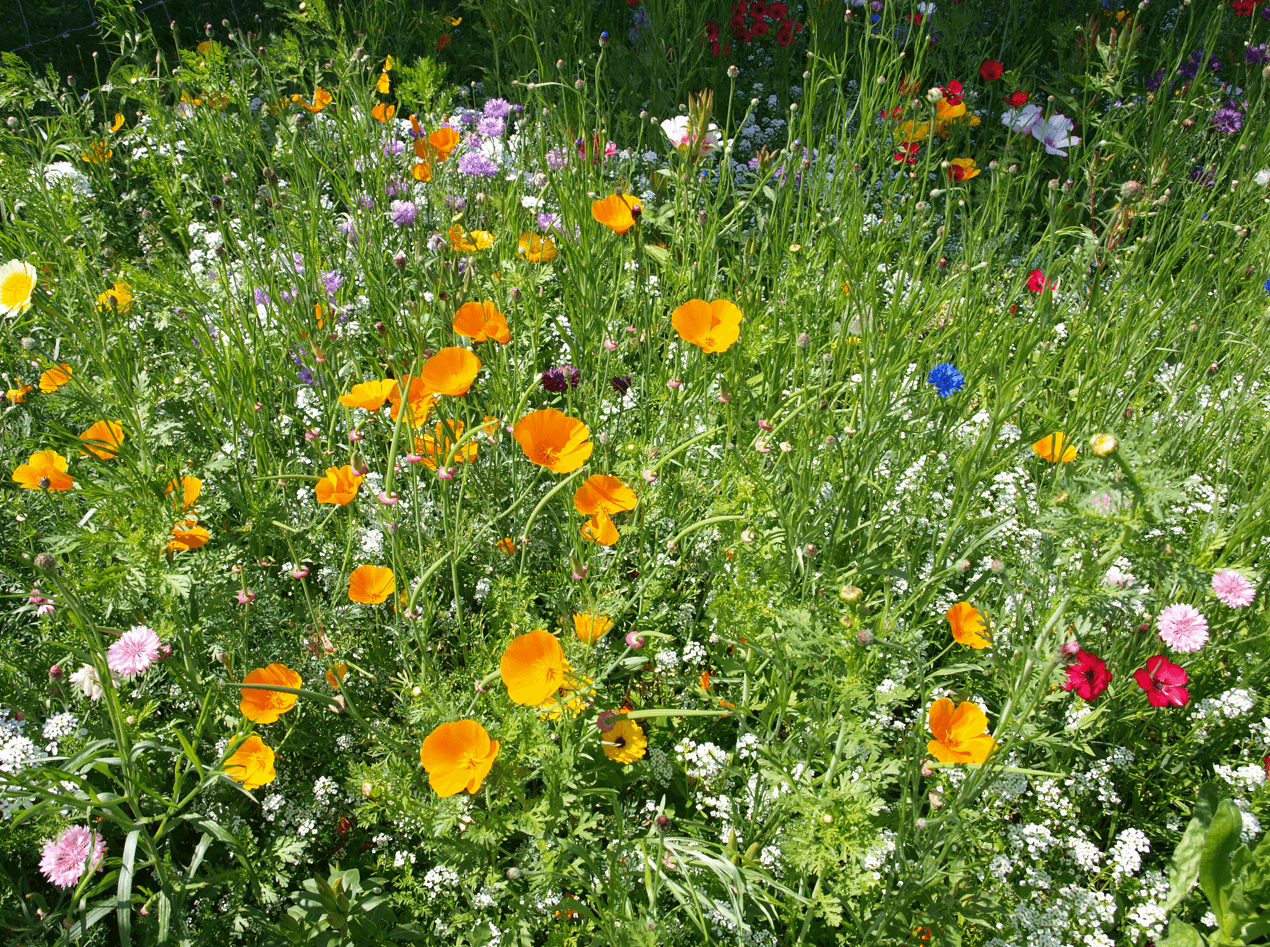
The insects themselves are eaten by birds, bats, amphibians, reptiles and small mammals, all of whom contribute to the cycle of life.
During winter when there is less food available, seeds can also be an important food source for birds and small mammals.
Plants can also be really helpful to keep soil healthy. When garden plants become established and spread their roots, they stabilise the surrounding soil.
This means that when there is a lot of rainfall, or irrigation in fields used to grow crops, soil particles and nutrients stored in the ground stick around and the soil stays healthy. This is especially important on hillsides, where sloping ground is easily washed away if there aren’t root systems to hold the soil in place.
Without plants that stabilise the soil, nutrients can get washed away into nearby water systems. This causes a problem called ‘eutrophication’, where algae spread and can make the water toxic to marine animals.
Over the past year our lake has had a bit of a shake-up in terms of its residents. In January 2022 our veteran Cob (male Swan) had to be taken off the lake by the RSPCA due to Avian Flu, unfortunately he passed away under their care and it wasn’t long before the Pen (female Swan) decided to leave the lake on her own. Thankfully, within a couple of weeks a brand-new pair of adult Swans arrived on the Lower Lake and began scouting out nesting areas. They have been well fed on our lake and seem to be settling in nicely, with the Pen being a lot more confident than the Cob. Hopefully in the 2023 breeding season they will produce some eggs and we could have some little Cygnets (baby Swans) on the lake again!
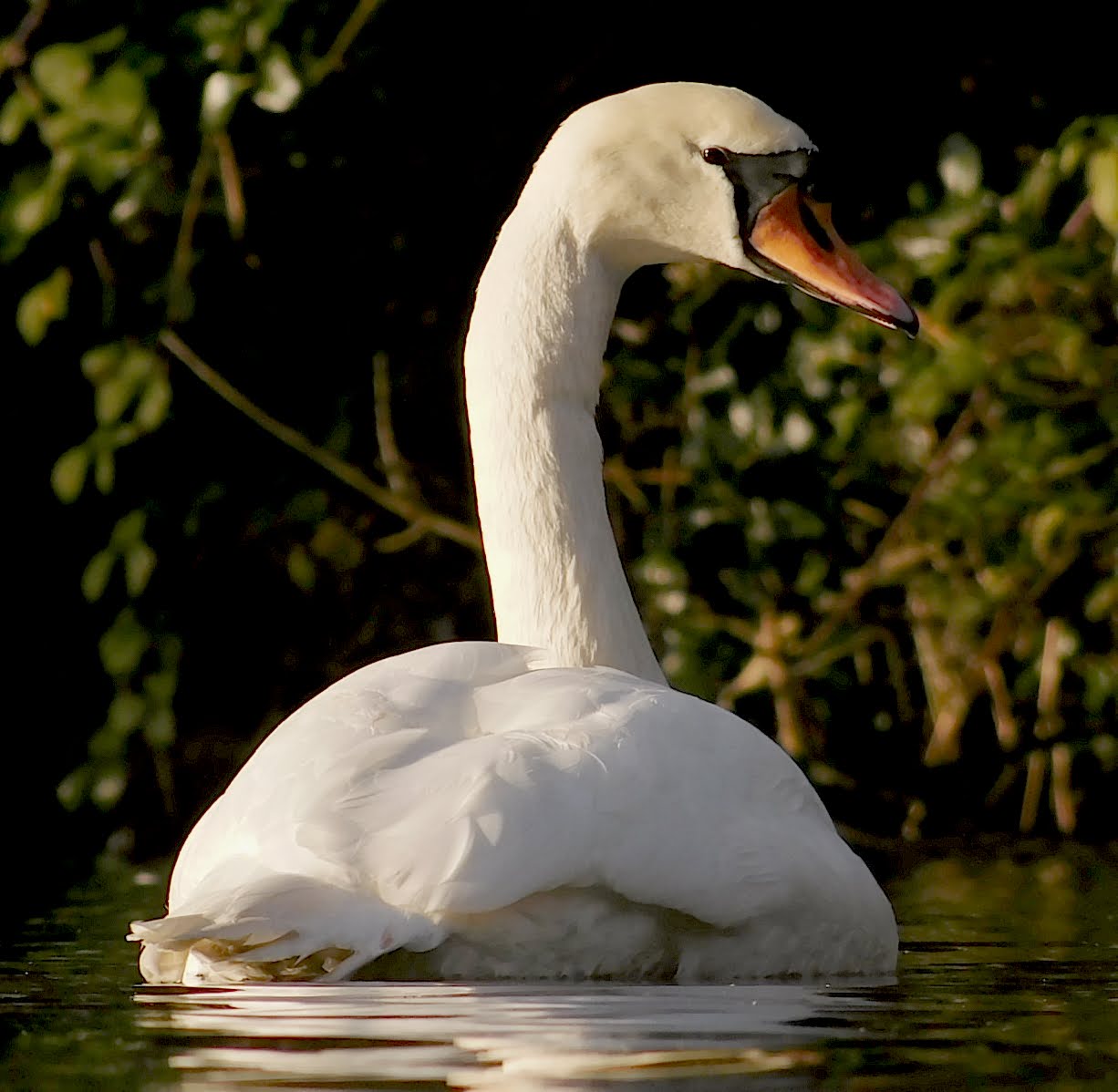 Picture © David Hart
Picture © David Hart
There have also been a few seasonal duck breeds coming to pay the park a visit; you may have spotted some visitors around our lakes recently! This is the time of year that migratory birds leave their own countries and come to us to take advantage of our milder winters. One of the first species that we’ve noticed this year is the tufted duck (Aythya fuligula). It is a medium size diving duck, a bit smaller than the usual Mallards on the lake. You can tell the males and females apart by their colouring, the males look black with white sides from a distant, whilst the females are a darkish brown on top with lighter sides. Both birds have golden/ yellow eyes and crests that are a tuft of feathers on their heads, although the females tuft is a lot less noticeable than the males.
The male tufted ducks have many more colours to their feathers when you get to see them closer, they have an attractive sheen of purples and green especially around mating time. The tufted ducks fly onto our lakes every year from northern Europe but you can find resident Tufted Ducks that remain all year round in parts of the country.
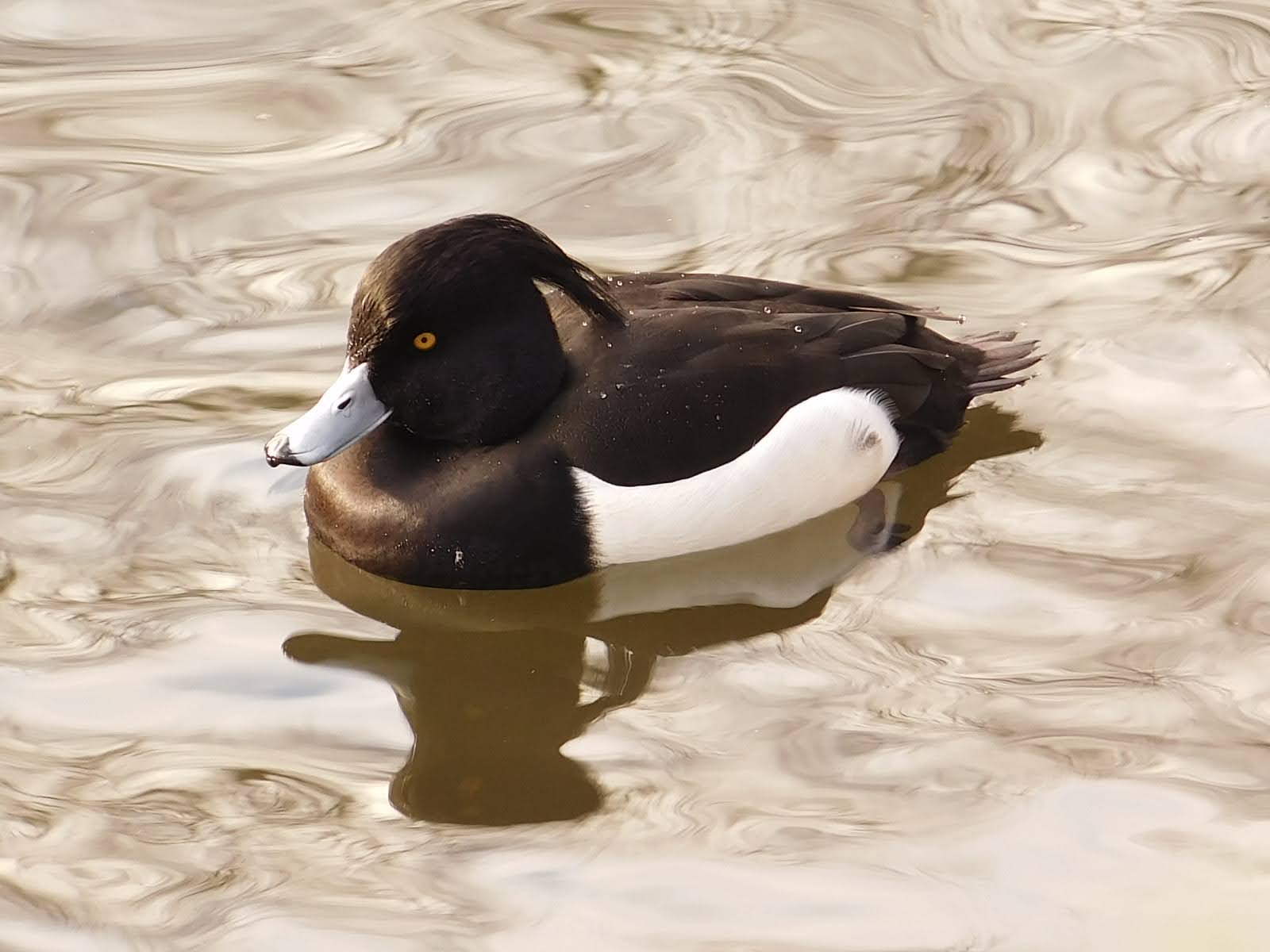 Picture © David Hart
Picture © David Hart
Also keep an eye out for the common Pochard and a timid brown-headed duck!
On Thursday November 10th 2022, the Duke of Devonshire, visited Princes Park Liverpool, and Birkenhead Park, to celebrate Joseph Paxton, designer of both parks.
The Duke was accompanied by both Friends’ groups and the Deputy Lord Mayor of Liverpool and the Mayor of Wirral.
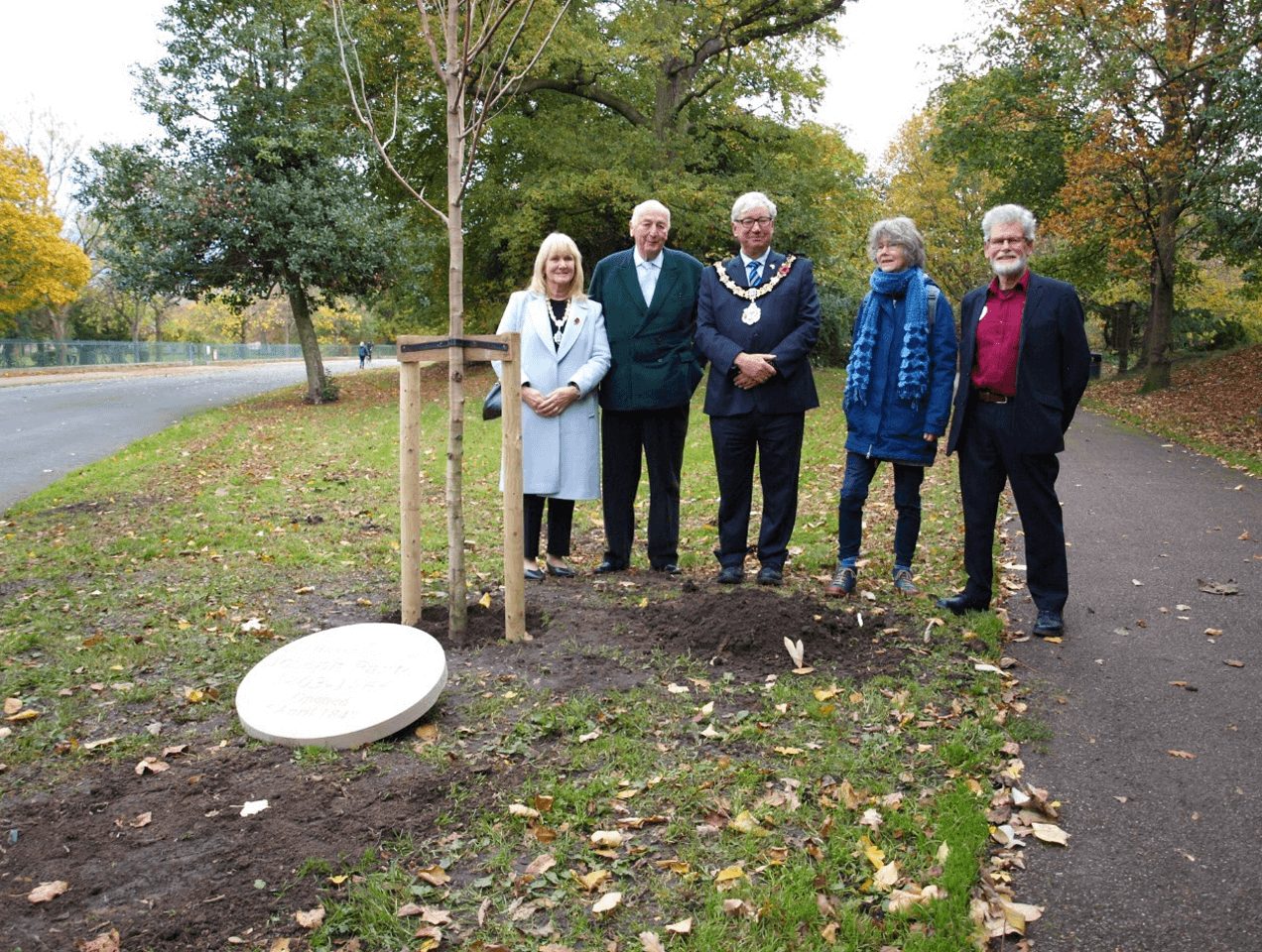
From left to right: Mayoress of Wirral, the Duke of Devonshire, Mayor of Wirral, Katy Gardner President of the Friends of Princes Park, Graham Arnold President of the Friends of Birkenhead Park
The 12th Duke of Devonshire planted a Chinese tulip tree in each park on Thursday November 10th to celebrate the life of Joseph Paxton, designer of both parks. The Duke was accompanied by the head gardener from Chatsworth Estate, Steve Porter. They were joined in Liverpool for the morning planting by The Deputy Lord Mayor, and in Birkenhead for the afternoon planting by the Mayor of Wirral.
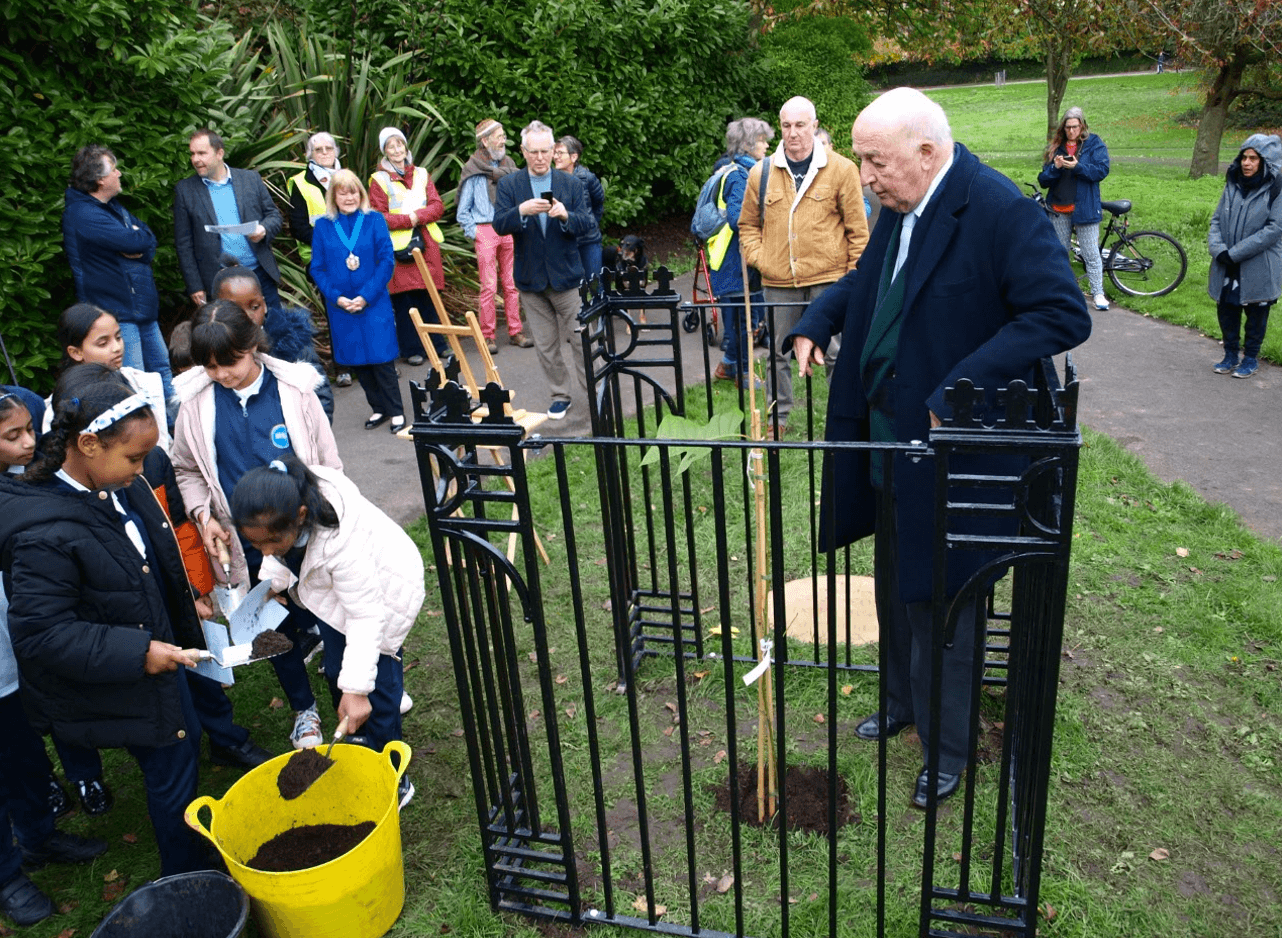
The Duke of Devonshire planting the Chinese Tulip tree with schoolchildren in Princes Park, Liverpool
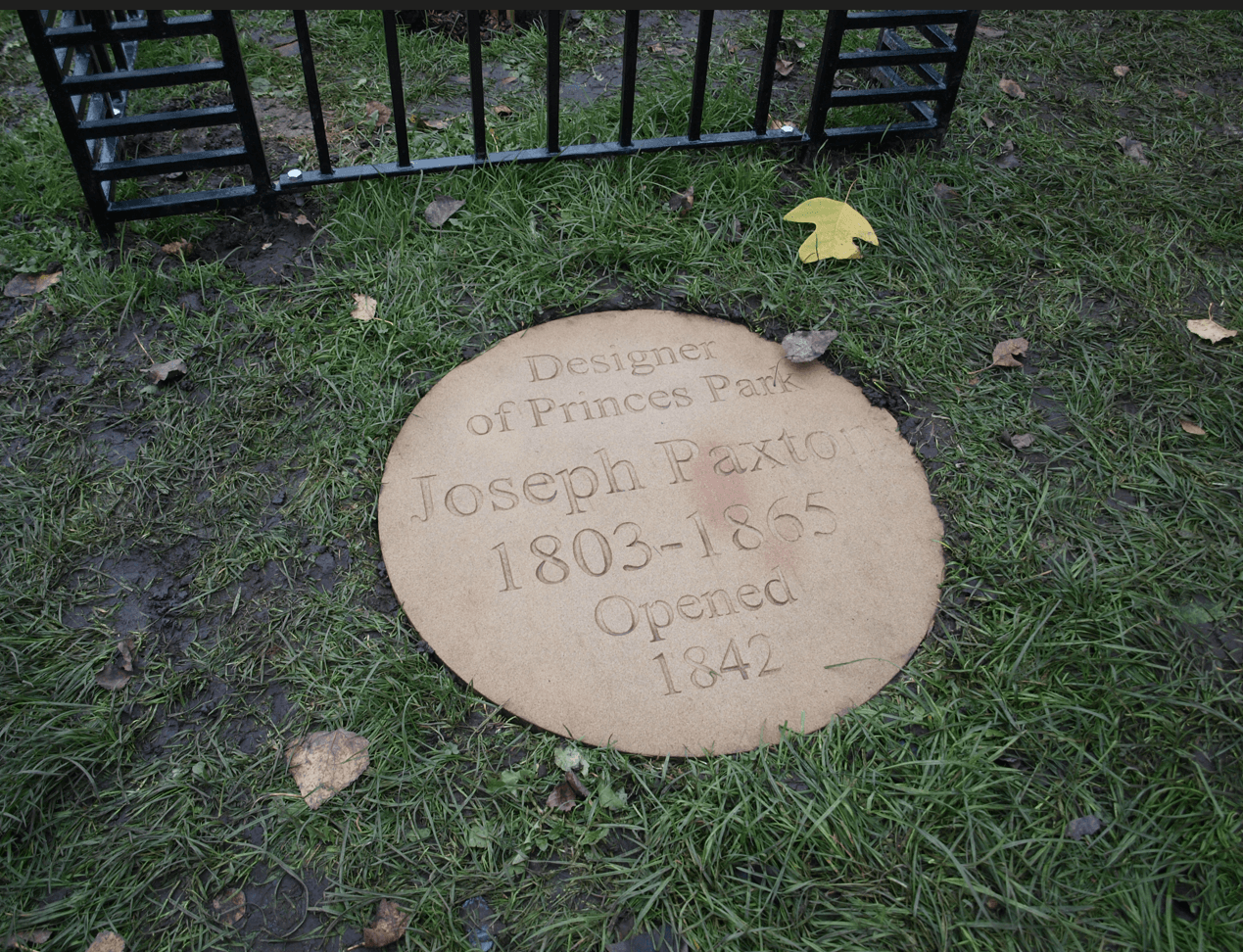
Joseph Paxton’s stone plaque in Princes Park, Liverpool
The Duke planted a third tree at his Chatsworth estate, where Paxton was head gardener for many years from 1826-1858, and which itself owes much to Paxton’s brilliant work.

Paxton’s commemoration Chinese Tulip Tree at Chatsworth Estate
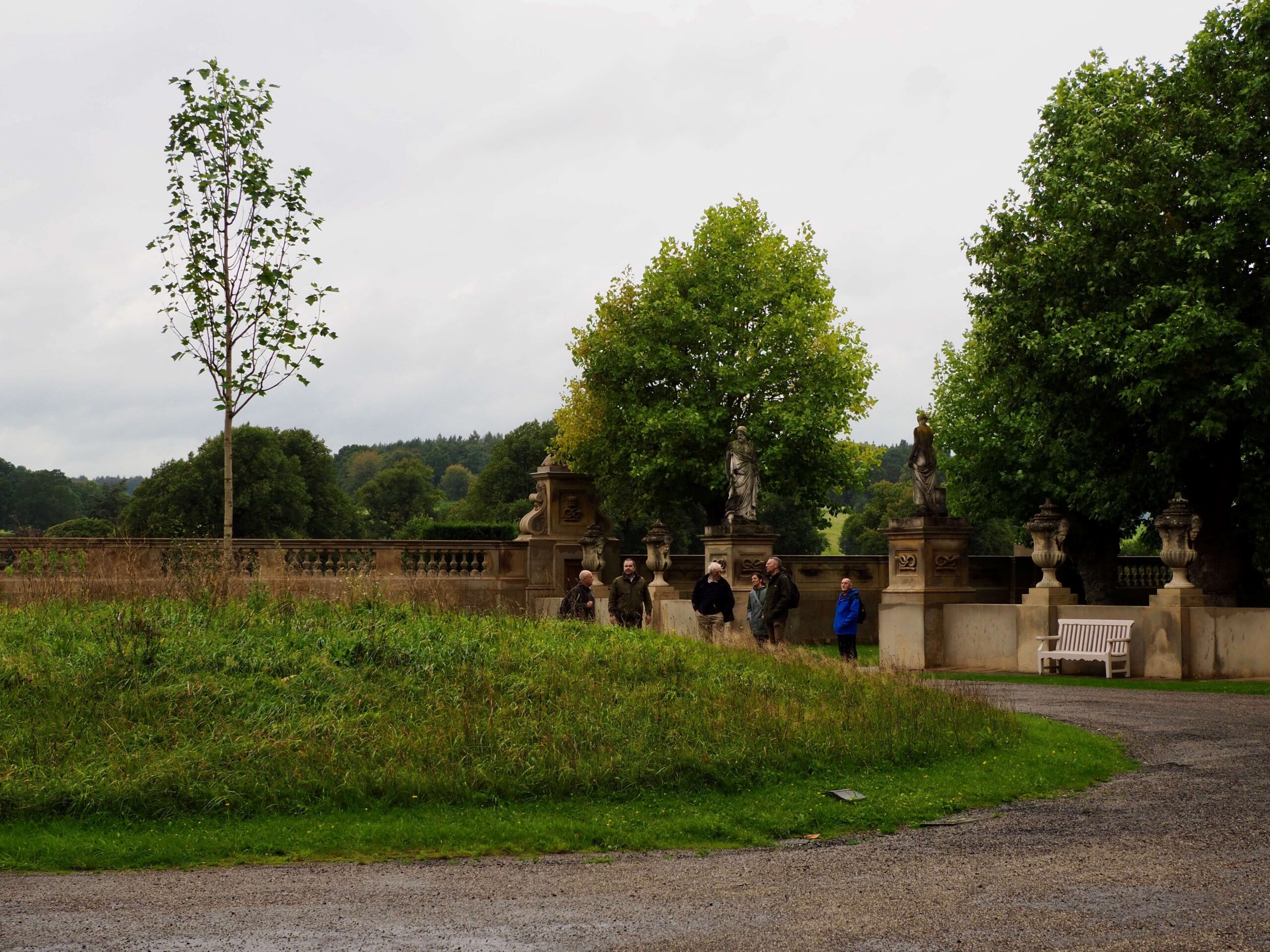
The Friends of Birkenhead Park and the Friends of Princes Park at Chatsworth Estate, November 2023
In 2022, Birkenhead Park celebrates its 175th anniversary this year. Princes Park was opened 5 years earlier and is celebrating its 180th anniversary. The Duke’s visit was hosted by the Friends of Birkenhead Park and the Friends of Princes Park. The two Friends groups have an excellent relationship, nurtured when, after the Duke’s last visit to Princes Park in 2014, both groups visited Chatsworth Estate at his invitation. Both Friends groups feel that this was a great opportunity to celebrate Joseph Paxton, who they feel has been under appreciated in Merseyside to date.

From left to right: Jimmy Ashcroft, Birkenhead Park’s Head Gardner, the Duke of Devonshire and Mayor of Wirral
Princes Park, Grade 2* listed, in Toxteth, has developed from neglect in the 80s and 90s, to a vibrant focal point for families and communities from Liverpool 8 and beyond today. During the recent pandemic the park was a haven for both people and wildlife. While working as head gardener of Chatsworth Estate Joseph Paxton designed Princes Park, one of the first private parks in England to have a public space within it. The park has unexpected views and winding paths, characteristic of Paxton’s work.
The 6th Duke of Devonshire was a mentor and friend to Joseph Paxton. Paxton, a man of great vision, went on to design, with collaborators, Birkenhead Park. Later, in 1851, the Crystal Palace in London was amongst his many achievements. John Robertson worked with Paxton on the design of Princes Park and later Birkenhead Park, and his descendant is an active member of the two Friends groups today.
Birkenhead Park, Grade 1 listed, is one of the UK’s foremost historic parks. It was the first municipally funded public park in the UK, and the inspiration for the creation of Central Park in New York. Like Princes Park, Birkenhead Park is a special place and a masterpiece of landscape design. Paxton created a place replicating the English pastoral countryside, while at the same time incorporating features such as lodges, bridges, and a boathouse. Since it opened in 1847, Birkenhead Park has provided a much-needed haven for active recreation with its cricket clubs, a place for strolling and contemplating nature. Wirral Council, with the support of the Friends of Birkenhead Park, is currently seeking its inclusion in the UK’s Tentative List for inscription as a UNESCO World Heritage Site.
Both parks installed, in addition to the tree, a stone plaque commemorating Paxton, laid in the ground by the tree. Each park also have a Paxton Blue Plaque installed.
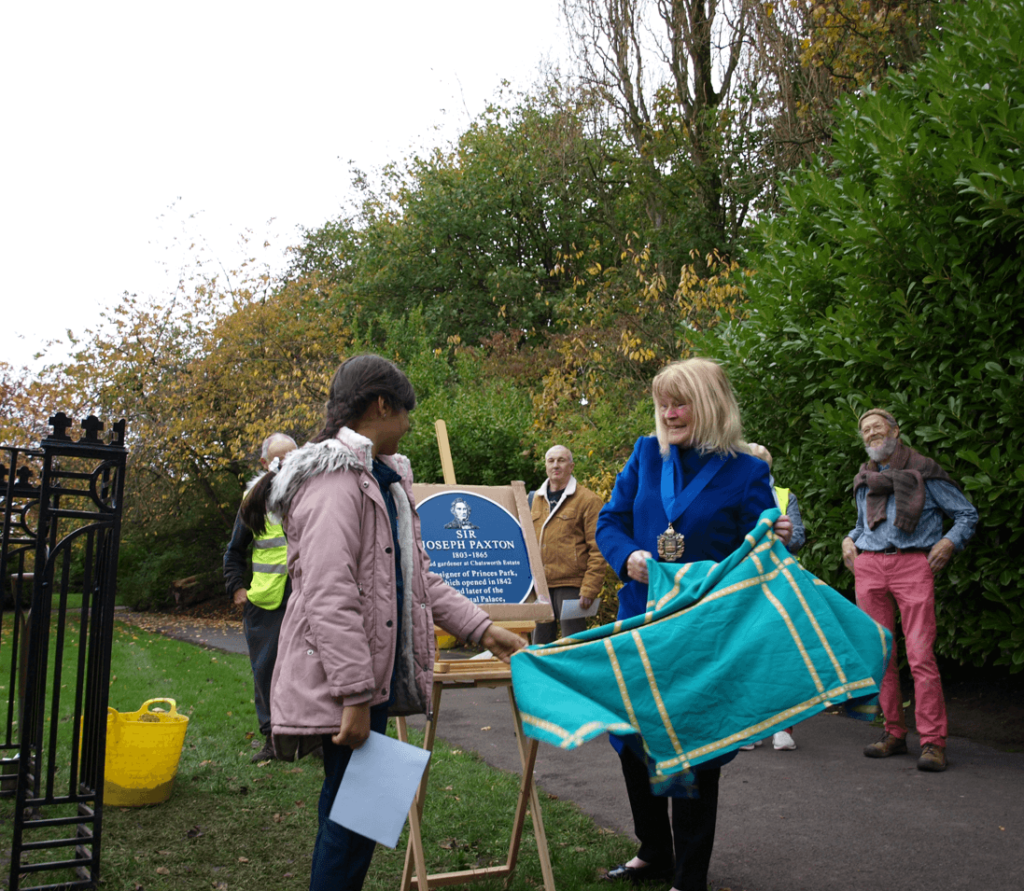
Deputy Mayor, Mary Rasmussen, unveiling the Joseph Paxton’s blue plaque in Princes Park, Liverpool

Mayor of Wirral unveiling Joseph Paxton’s blue plaque in Birkenhead Park
In Princes Park the Duke and Lord Mayor visited the proposed site for the new Mandela bridge to the island. Originally there was a Chinese bridge at this site, like the Swiss Bridge in Birkenhead Park. The new bridge will be modern and minimalist. Princes Park has become a place for remembering Nelson Mandela, and community organisation Mandela 8 is organising the island space and bridge work.
In Birkenhead Park the Duke and the Mayor of Wirral joined both Friends’ groups for a buffet in the Visitor Centre before the tree planting.
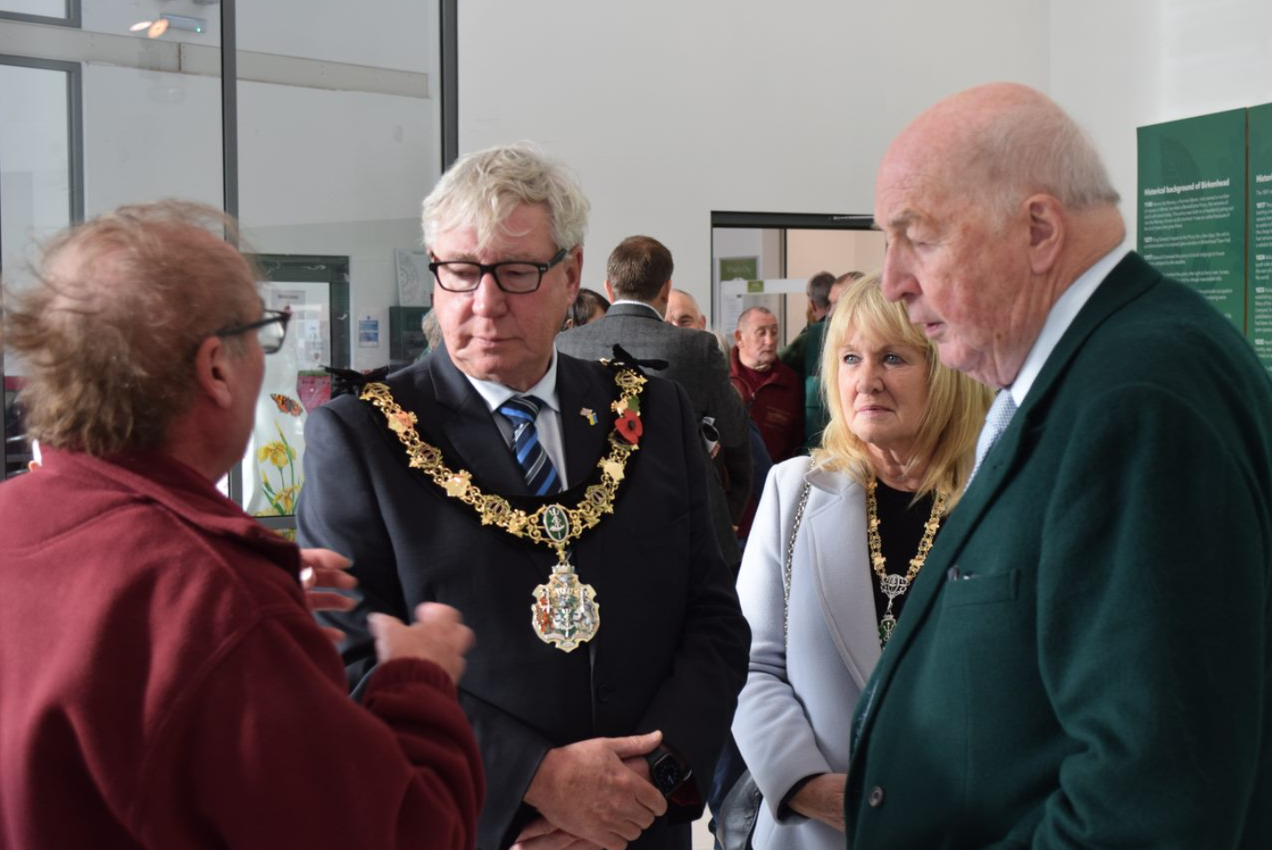
The Duke of Devonshire welcomed by the Friends of Birkenhead Park at the park’s Visitor Centre
Learn more:
Birkenhead Park is a very special place for many reasons. Amongst others, it is reputed to be the first public park ever created by a municipal authority and consequently it inspired the development and creation of parks right across the world. Perhaps the most well-known is Central Park in New York.
Birkenhead Park is a pioneering ‘People’s Park’ which is historically and culturally important to the communities of Wirral, as well as to the UK and the rest of the world. Nationally, its significance is recognised by its listing at Grade I – the highest grading – by Historic England on the Register of Parks and Gardens of Special Historic Interest. Birkenhead Park is one of only a handful of public parks outside London to achieve this recognition.
For several years, it has been an ambition of Wirral Council and partners – including the Friends of Birkenhead Park – to seek UNESCO’s recognition of the park and its immediate surroundings as a World Heritage Site. UNESCO is the United Nations Educational, Scientific and Cultural Organization and one of its roles is to designate World Heritage Sites.
Earlier this year, the opportunity arose to make progress towards this and in July 2022, Wirral Council made an application for Birkenhead Park to join the UK’s Tentative List of World Heritage Sites. Following the submission of the application, the Department for Digital, Culture, Media and Sport announced on Monday 10th April 2023 that Birkenhead Park would be included on the UK Tentative List for potential nomination for inscription on the UNESCO World Heritage List.
We’ve put together some ‘frequently asked questions’ which will help you understand more about this ambition and what it may mean for the park, our visitors and our neighbours and local communities.
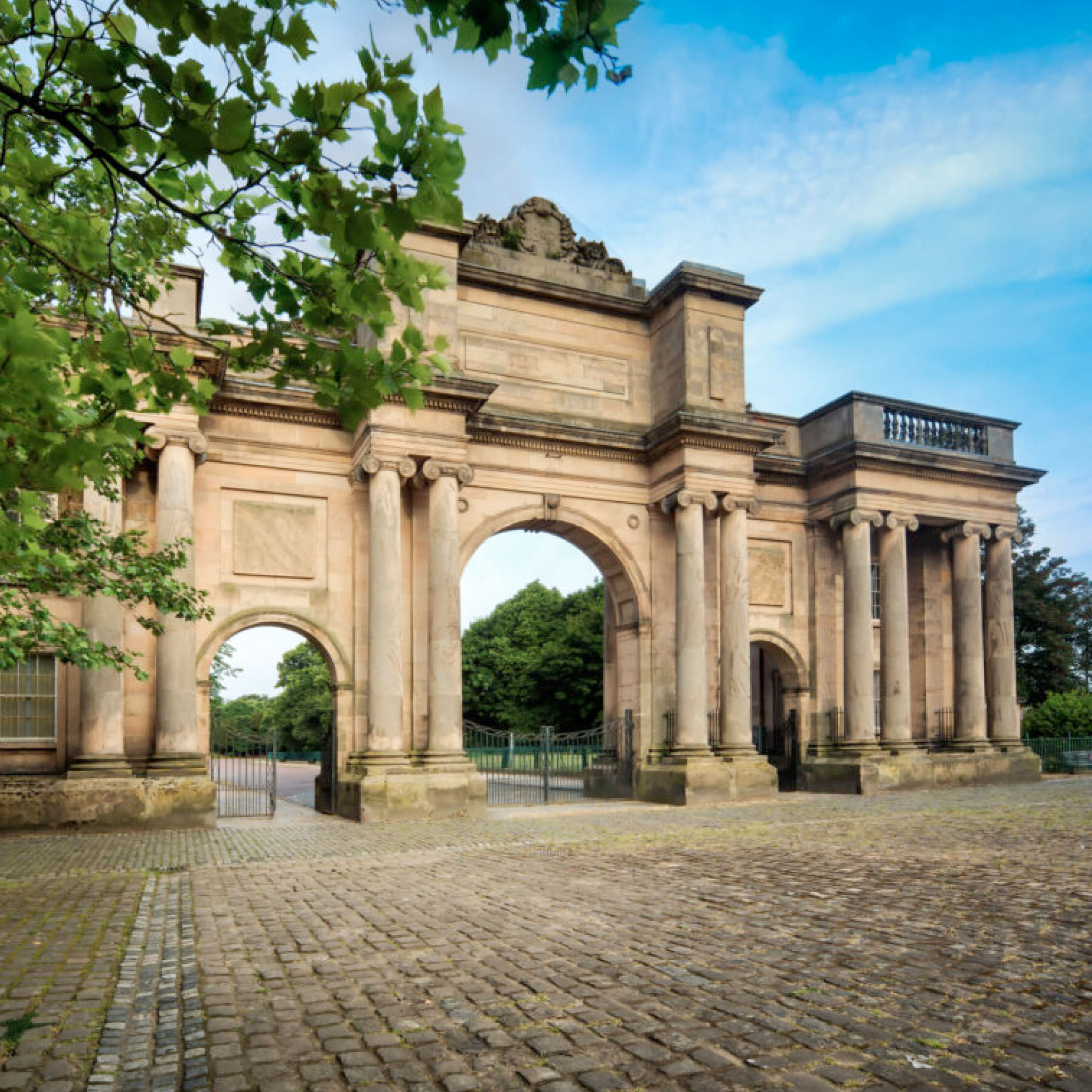
What is the ‘Tentative List’?
Before applying to become a UNESCO World Heritage Site, a site must be included on its national government’s ‘waiting list’ of potential sites, called the ‘Tentative List’.
By being added to the UK’s Tentative List, Birkenhead Park becomes one of the potential sites to be formally nominated by the UK government to UNESCO in the next ten years.
When might Birkenhead Park become a UNESCO World Heritage Site?
Applying to become a UNESCO World Heritage Site is a long process that could take 10 years or so. It’s not possible to be precise because the time will depend on many factors.
Following the inscription on the UK’s Tentative List, Wirral Council will work closely with Historic England, the relevant UK government departments and other national and international partners, to develop the park’s nomination to UNESCO. This process can take several years and will involve thorough assessments along the way. Indeed, being invited to join the UK’s Tentative List by no means guarantees that a site will progress to be nominated.
However, assuming Birkenhead Park gets to the stage of nomination, it will be the UK government’s responsibility for making the formal application to UNESCO. As it stands, the UK government will generally submit a site for nomination every other year. The most recent UK site inscribed on the UNESCO World Heritage List in 2021 was The Slate Landscape of Northwest Wales.
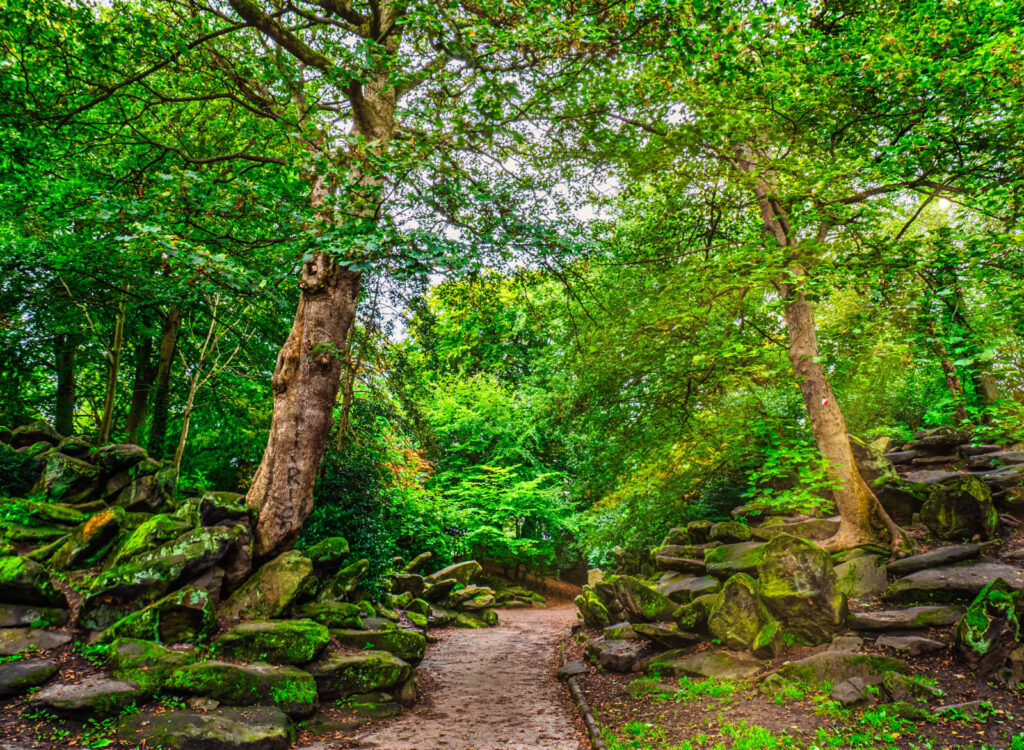
What’s so special about Birkenhead Park that it might be a World Heritage Site?
Birkenhead Park is very special – and we believe that it should be recognised as such. It is one of Britain’s foremost public parks and the forerunner of the development of public parks around the world. We believe that Birkenhead Park meets three of UNESCO’s ten criteria (i, ii, and iv) for selecting World Heritage Sites.
- To represent a masterpiece of human creative genius
- To exhibit an important interchange of human values, over a span of time or within a cultural area of the world, on developments in architecture or technology, monumental arts, town-planning or landscape design
- To be an outstanding example of a type of building, architectural or technological ensemble or landscape which illustrates (a) significant stage(s) in human history
For more information on UNESCO World Heritage criteria visit UNESCO website
Recently, the pandemic has demonstrated how crucial urban public parks are for people’s health and wellbeing. The inscription of Birkenhead Park on the World Heritage List would be a significant step in acknowledging that and help in safeguarding their future for generations.
What are the benefits of becoming a World Heritage Site?
Achieving World Heritage status for Birkenhead Park would bring many opportunities and benefits to the local community, businesses and the borough of Wirral, including:
- Acknowledging the role played by Birkenhead in the development of public parks around the world
- Raising awareness about the park’s global significance
- Strengthening the protection of the park for future generations to enjoy
- Increasing the sense of pride of local communities for their heritage and identity
- Attracting more national and international tourists and visitors, creating new opportunities for local businesses and boosting the local economy
- Better connecting together local residents and those who visit and enjoy the park
- Creating new funding opportunities for the park and its surroundings.
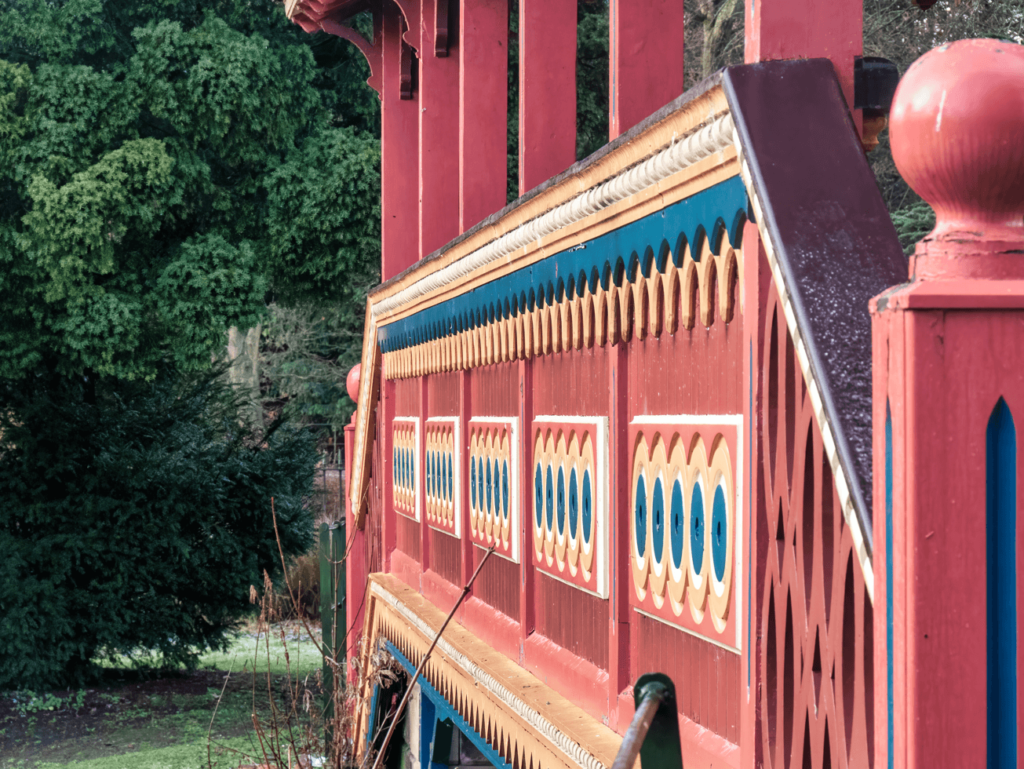
If Birkenhead Park becomes a World Heritage Site what will that mean for proposed developments and changes in and around it?
As we progress to the next stage – working on the submission of a nomination to UNESCO – the proposed World Heritage Site (the park and its immediate surroundings) will need to be looked after to the highest possible standards. That means that any proposed changes will also need to fully consider the heritage value and significance of the park and be ‘appropriate’ to that. This will be important in making sure that what is special about the place is preserved and enhanced.
Birkenhead Park is a Grade I listed Park. It is already located within a designated Conservation Area and a significant number of surrounding properties are also listed buildings. World Heritage Site status would not prevent appropriate improvements, but it would require a thorough appraisal of any development proposal. Of course, being a World Heritage Site will be advantageous in attracting additional funds to enable such high quality and suitable changes.
If you have more questions about Birkenhead Park’s journey to become a UNESCO World Heritage Site, do not hesitate to get in touch with us.
A 27-foot-high sculpture of an angel came to Birkenhead Park in July as part of a nationwide campaign tour highlighting the reality of knife and other violent crime.
The Knife Angel visited Birkenhead Park as part of its National Anti-Violence Tour. It was located at the park’s Grand Entrance.
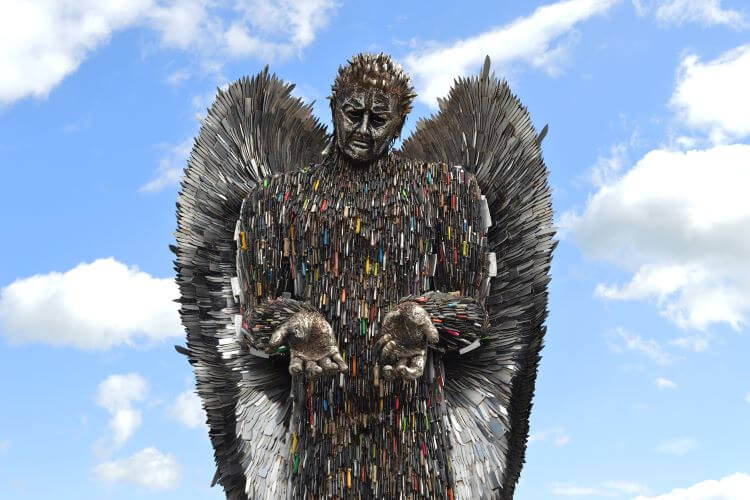
The Knife Angel is a huge, stunning contemporary sculpture of an angel made out of 100,000 confiscated knives received from 43 Police Forces across the UK. It weighs in at a hefty 3.5 tonnes.
Originating from The British Ironwork Centre in Oswestry and created by sculptor Alfie Bradley, it is on tour of towns and cities around Britain raising awareness of the issues of knife crime and all forms of violence and aggression.
Birkenhead is the only location in Merseyside where it was displayed this year and as well as providing a focal point to get people talking about violent crime, it also acted as the centrepiece for wider collaborative education and awareness-raising work involving Wirral Council, Merseyside Police, the Community, Voluntary and Faith sector, local businesses, Youth Offending Team, local schools, Wirral Change and Tomorrow’s Women, amongst others.
According to the British Ironwork Centre, they created the Knife Angel as a vehicle to voice the concerns of the nation, its communities, families, and the victims that have tragically been affected. The Knife Angel, under the ‘Save a Life, Surrender your Knife’ campaign, spearheads change and seeks to ensure there is more of a focus on early intervention, awareness raising and education throughout the UK.
The Knife Angel encourages the surrender of knives and was constructed using weapons handed in to police forces as part of an amnesty appeal in 2015 and 2016. Surrender bins for the safe disposal of knives in Wirral were in place next to the sculpture whilst it was in the area.
Merseyside’s Police Commissioner Emily Spurrell said: “The Knife Angel is a stark reminder of the devastating impact of knife crime on individuals, families and communities.
“Sadly, we have seen those heart-breaking consequences right here in Merseyside too many times.
“Wherever the Knife Angel has visited, it has acted as a powerful call to action. It has brought people together to renew their commitment to preventing and tackling the use of knives, while providing an opportunity to remember those who lives have been lost or irrevocably changed.
“So, I’m delighted the Knife Angel will soon be arriving on the Wirral and I hope it will have a similar impact here. I know its visit is already acting as the inspiration for a whole series of events and activities focused on stopping knife crime.
“If we are to truly make our communities safer, we must all pull together to increase awareness and education, divert young people away from crime and prevent these tragedies from ever taking place.”
Wirral Council leader, Cllr Janette Williamson, added: “Knife crime and other violent offences sadly continue to be a serious cause of concern within our communities. The presence of the Knife Angel in Birkenhead will reinforce the work that is already under way by community safety partners in Wirral and the rest of Merseyside to reduce incidents and help residents feel safer.
“I’d encourage as many people as possible to visit it and maybe engage with one of the many related events taking place in July.”
Superintendent Martin Earl from Merseyside Police said: “We are pleased to welcome the Knife Angel to Wirral to kick off a whole series of community events, which we hope will start a discussion on the issue of knife crime within the community.
“Sadly, we all know the devastating consequences knife crime can have and we’ve seen its effects on victims, their families and the community as a whole.
“The Knife Angel starts a conversation and it’s important that we all stop and think about violent crime. Preventing this kind of crime is a priority for the force, but we know we can’t do it alone – we need to continue our work with communities, partners, schools and young people.
“By taking a collaborative stance with our partners, we will continue to educate, enforce and act on any information given to us to bring those involved in this type of offending to justice.”
The Knife Angel’s arrival in Wirral was backed up by a month-long series of events, workshops and other activities across the borough involving a range of organisations and people of all ages and backgrounds.
The Knife Angel’s time in Wirral concluded with a candlelit vigil/memorial event in Birkenhead Park.
Let It Grow, Let it Grooooow!
From 2022, Birkenhead Park is taking part in the annual “No Mow May” scheme in accordance with Plantlife’s national campaign. Across Birkenhead Park we have allocated a little over 18 acres of our grassland to grow longer throughout May, allowing our bees, butterflies and other pollinators, a chance to flourish at a crucial time. We’ve signposted the areas of the park where this is taking place, but don’t worry – we’ve left plenty of areas for you to continue to enjoy and we’ll continue to maintain them as normal!
Want to do your part help with the scheme yourself? Simply lock up your mower for May and let your law grow some wildflowers. Clink the link below for more information on “No Mow May."
Find Out MoreOn Wednesday the 30th of March, the Edward Kemp Community Garden had a double celebration. Firstly the 10th birthday of the garden, postponed for a year because of Covid restrictions – many of the garden users enjoyed meeting others and enjoying refreshments -, the second reason was celebrating a grant from the Duchy of Lancaster The Deputy Lieutenants Dr Nicholas Jedynakiewicz and John Robert were there to open the new environmentally friendly mower and strimmer and some other traditional gardening tools.

Edward Kemp Community Garden and Growing Area
The original intention for the site now occupied by the Edward Kemp Community Garden and Growing Area had probably been to construct a couple of elegant mid-Victorian villas, but these plans never came to fruition. Instead, it became part of the Field Lawn Tennis Club, but after the Second World War it was managed by Birkenhead’s Education Committee as a sports facility for local schools. However, by the early 1970s this was no longer the case; the fine wooden sports pavilion (originally built by the Tennis Club) was destroyed by arson; and the area became derelict, at a time when Birkenhead Park as a whole was suffering significantly from increasing neglect and a reduction in Local Authority funding.
It is in the last 10 years that this situation has been transformed by the creation of the Edward Kemp Community Garden and Growing Area as a result of a project drawn up by Park Roots Community Interest Company, the trading arm of the Friends of Birkenhead Park (established in 1976).
It has involved the creation of a number of community plots and a community garden designed to enable youth groups, schoolchildren, and members of local residents associations to learn about flora and fauna and to grow their own flowers, fruit and vegetables. It has also become an important centre for learning and practicing key horticultural and gardening skills. It now boasts a sensory garden, a small orchard, and a natural well, and has become a real community asset for the people of Birkenhead and further afield.
On the 5th of April 1847, Birkenhead Park officially opened its gates for everyone to enjoy – making it a real time of celebration for people living in Birkenhead and the surrounding areas. Back then, it was the first park in Britain to be purpose-built by a local authority and funded by public money.

2022 marks the 175th anniversary of the park. Celebrations will start on Tuesday the 5th of April with a closed civic reception at the park’s Visitor Centre attended by The Lord-Lieutenant for Merseyside, Mr Mark Blundell, The High Sheriff of Merseyside, Mr Nigel Lanceley, and The Mayor of Wirral (Cllr George Davies). Celebratory anniversary cakes will be baked by current and former students from Wirral Met College, and pupils from Priory Parish School will create a piece of land art from natural material gathered from the park, that will be displayed until the 11th of April at the back of the Visitor Centre. On that same day, the Friends of Birkenhead Park will plant a memorial tree – an Evergreen Oak – to commemorate the Queen’s Platinum Jubilee. Last but not least, a new exhibition, ‘Birkenhead Park through the ages’, will also open to visitors at the park’s Visitor Centre. This exhibition will display previously unseen archive photographs of the park kindly offered by Birkenhead Reference Library, together with contemporary pictures taken by the local photographers from Birkenhead Photographic Association. The exhibition will be free of charge and open to visitors from 5 April to 19 May, everyday from 9.30am until 4.30pm.

The following weekend will be the anniversary launch weekend, open to all, as the park hosts ‘A Day Out in the Park’ on Sunday 10 April. Something for everyone will be available including a funfair, bike activities, a heritage open house at the park’s Central Lodge, a sing-a-long near the Visitor Centre and a visit from vintage buses from Wirral’s Transport Museum.
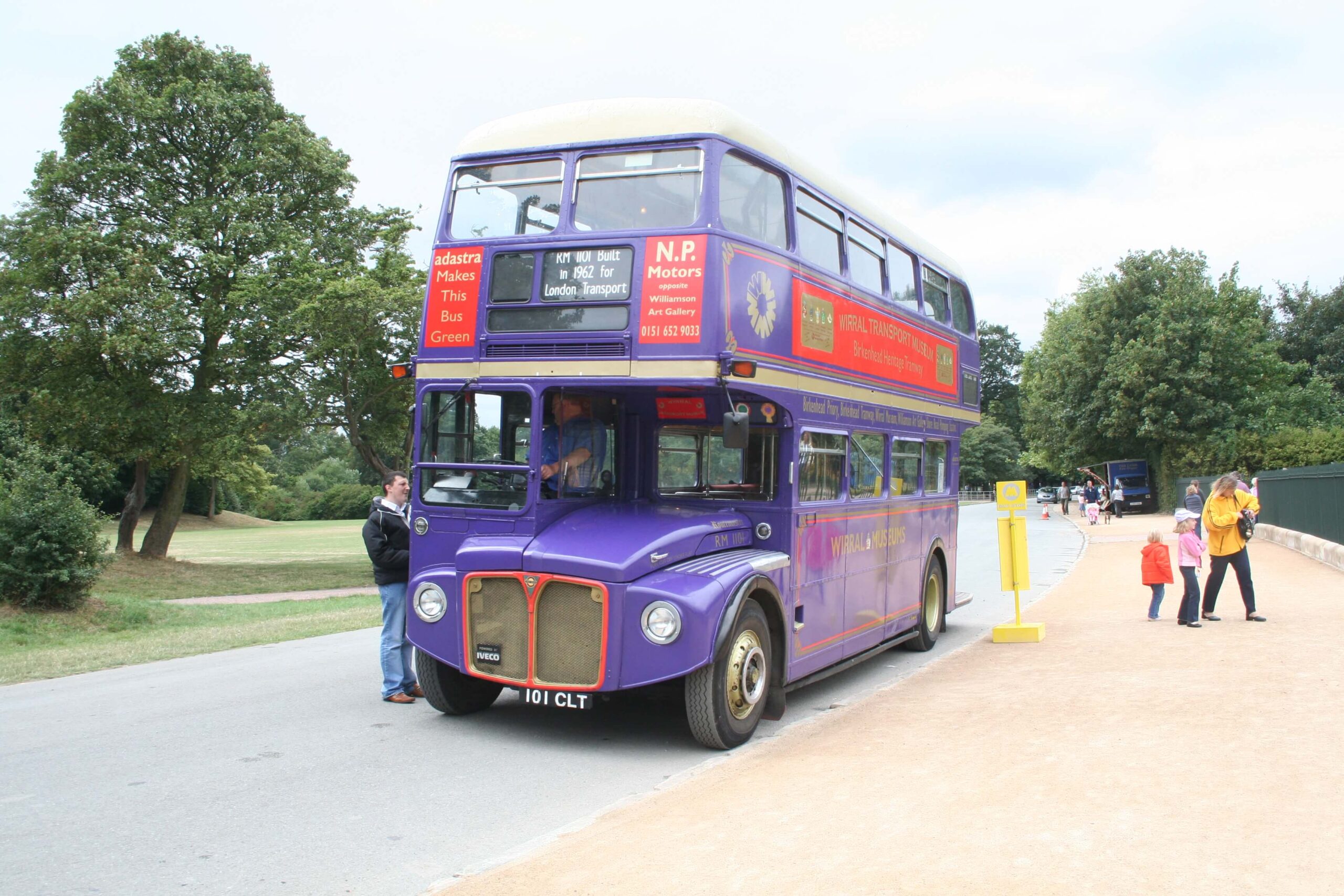
Local youth organisation HYPE will open the doors of its Victorian sweet shop located in the park’s Grand Entrance and will use this opportunity to launch their wonderful ‘Urban Walled Garden’. If you’re a keen singer, do not hesitate to join ‘Birkenhead Sings’ for a sing-a-long session by the Visitors Centre in Birkenhead Park from 1pm to 2pm (all welcome). Maybe it’s your chance to sign up for a new venture – the 175 Choir? Following the day, if you want to sign up, the choir will rehearse weekly with musical director Chris Watson at 11am on Saturday mornings (starting Saturday April 23rd).

The funfair will be set up near the park’s play area, and will be open every day, 12pm to 5pm, from Saturday 9 April until 24 April for families to enjoy both during ‘A Day out in Birkenhead Park’ and throughout the anniversary month.
We are launching this new, dedicated website to coincide with a year-long programme of activities in celebration of the park’s 175th anniversary, which will start in April this year.
Birkenhead Park is widely accepted as a global pioneer for publicly-funded parks and is the model upon which some of the most famous public parks around the world – including New York City’s Central Park – were based.
Since it opened in 1847, the extensive parkland has provided a much-needed sanctuary for local people to escape the busy urban environment. It was designed by Joseph Paxton – with the support of Edward Kemp – and set out to create a place which replicated the pastoral countryside and included an assortment of features such as lodges, bridges and a boathouse.

Events specifically linked to the anniversary of the park this year include a civic reception on 5th April, marking 175 years to the day of the park’s opening back in 1847. The ceremony will be led by Wirral Mayor Cllr George Davies, as well as other Merseyside dignitaries and will involve the cutting of a special anniversary cake in honour of 175 years of Birkenhead Park and a tree planting to coincide with the Queen’s Platinum Jubilee. There will also be a fairground and the opening of a photographic exhibition in the Visitor Centre called ‘Birkenhead Park: Through the Ages’.
A full schedule for the year will be published on this website.
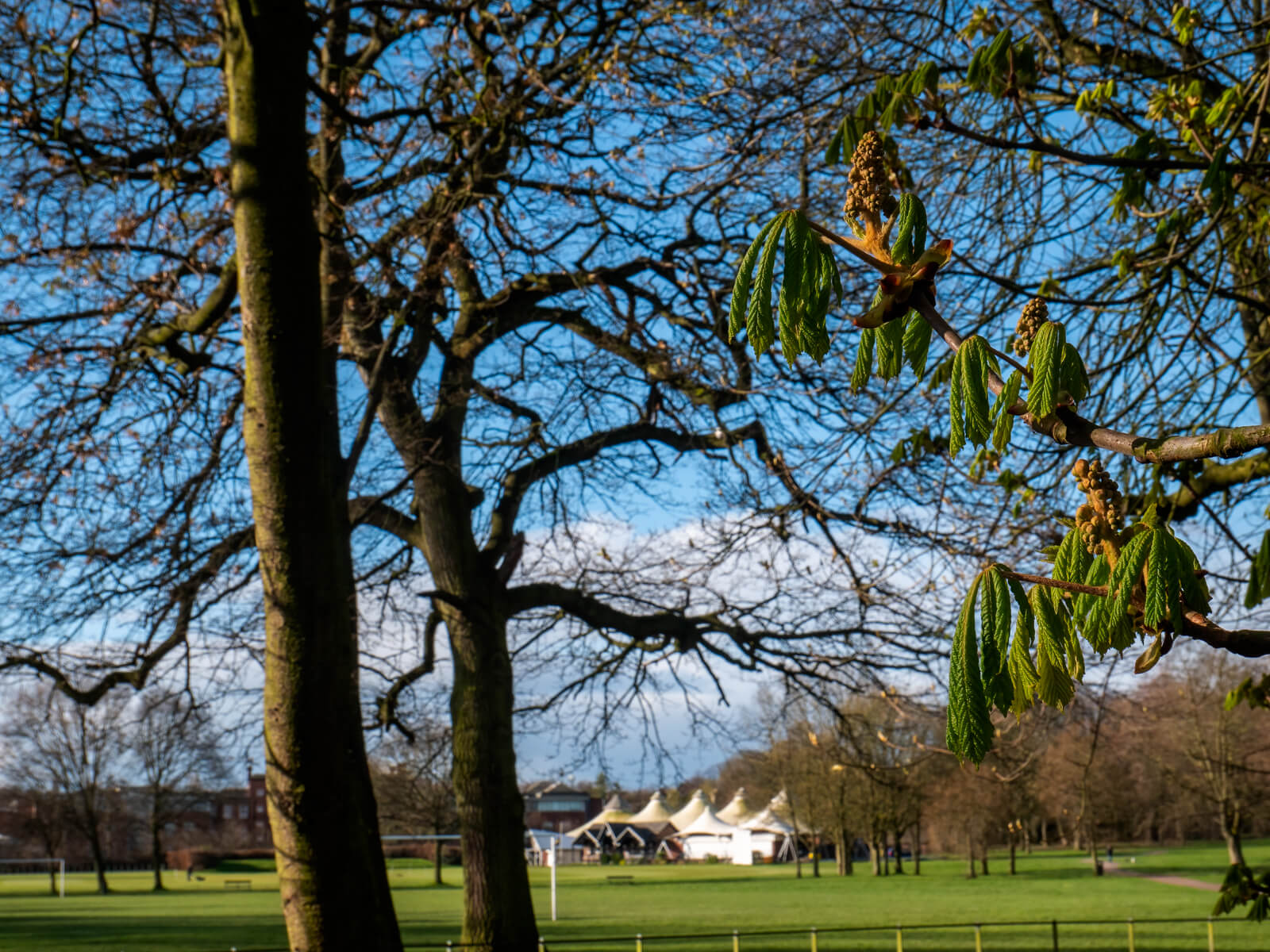
To keep up to date with the programme, don’t forget to subscribe to our Newsletter ↓
Birkenhead Park has a rich and colourful history since its opening on Monday 5th April 1847. Seen as the forerunner of the Parks movement, Birkenhead Park has acted as the inspiration and template for countless other urban parks across the UK, Europe and North America. Since its opening, it the park has supported its local community through two global conflicts, played host to countless sports events with teams from across the World, all whilst maintaining its beautiful architecture and wondrous landscape.
Birkenhead Park will forever be the people’s park.
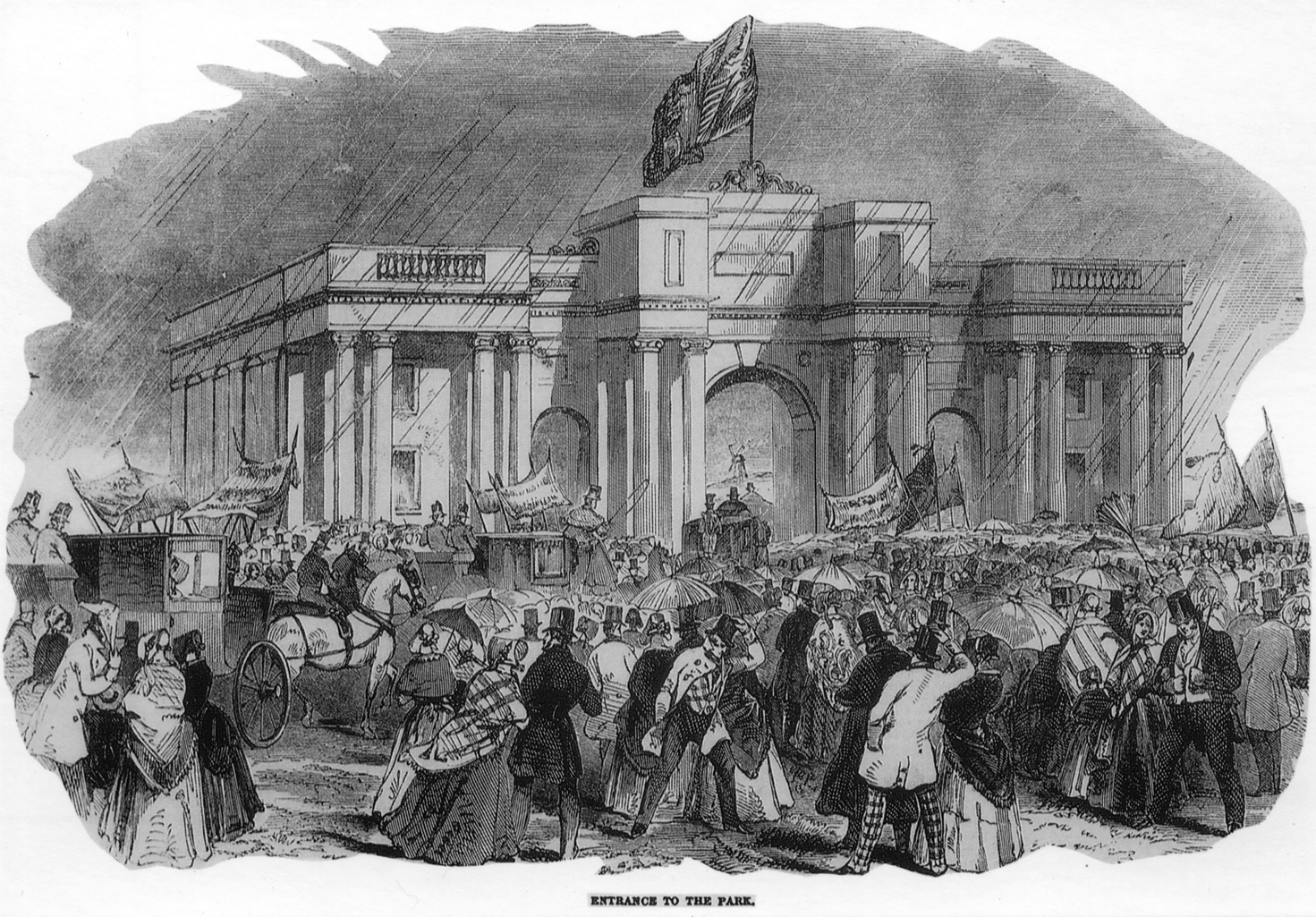
Conception and Opening
In the early – mid 19th century leading local industrialists, William Jackson, Macgregor Laird and Thomas Brassey, had a vision of building a ‘City of the Future’ on the Mersey, opposite the thriving city of Liverpool, which saw the town of Birkenhead experience a huge population increase (from 200 in 1821 to more than 24,000 in 1851). In 1840, the select committee on the Health of Towns declared preventative measures were required for reasons of humanity and justice to the poor, over conditions arising from the rapid expansion of urban populations. In 1841, Isaac Holmes – Liverpool Councillor and Birkenhead Improvement Commissioner – suggested that Birkenhead should have a public park.
In 1843 Act of Parliament gave the Birkenhead Improvement Commissioners authority to borrow money for the purchase of land to create a public park. Several important merchant and businessmen had been buying areas of land in and around Birkenhead. This land consisted of former farmland, mainly arable fields and former pastures, ill-drained meadows and commons, and was re-sold to the commissioners of the Park.
The chairman of the Birkenhead Improvement Commissioners invited Joseph Paxton, head gardener at Chatsworth to design the park, to which he agreed for a fee of £800. The plan for Birkenhead Park incorporated a park bounded by a carriage drive and areas around the edge of the park were set aside for the construction of villas in order to recoup the cost of paying for the park.
At Paxton’s behest, Edward Kemp supervised the development of the park and was appointed Park superintendent. As a close associated of Paxton’s, Kemp maintained and enriched the character of the landscape within the idiom described by Paxton. Kemp remained as superintendent of the park for forty years.
Birkenhead Park was officially opened on Monday 5th April 1847 by Lord Morpeth to a crowd of 10,000 people at the Grand Entrance. Despite having been completed almost 6 months earlier, the park’s opening was delayed in order to coincide with the opening of the Morpeth Dock complex in Birkenhead. Since then, Birkenhead Park has remained largely unchanged. Its originality and integrity remain intact, whilst it continues to modernise to suit the ever-changing needs and requirements of its visitors.




